CHAMPION WISTERIAS, CARNIVEROUS PLANTS, A SECRET CHURCH GARDEN
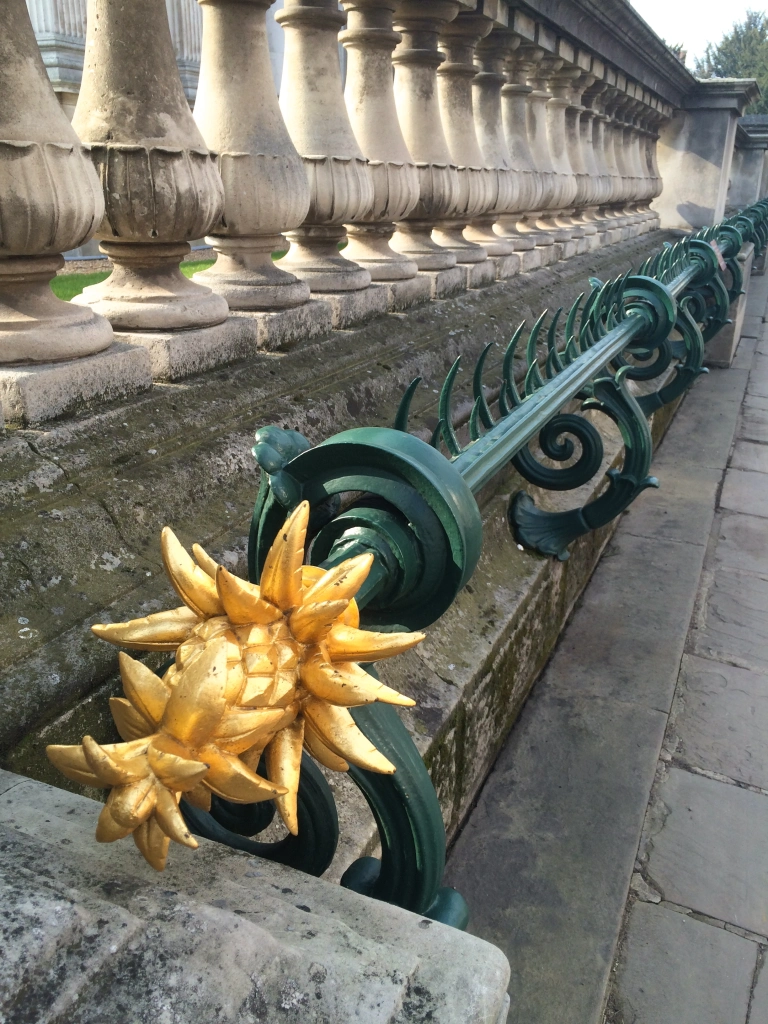 Bronze green and 23.5 carat gold railings, Fitzwilliam Museum, Cambridge
Bronze green and 23.5 carat gold railings, Fitzwilliam Museum, Cambridge
It has been a hard, grey start to the year. Just as spring is on its way I have been struck down with every kind of cold and reduced to spending many hours doing very little on the sofa.
I am cheered up by a splendid parcel of single snowdrops in the green from the charismatic Cambo Estate near St Andrews – see my October 2015 post on Cambo.
The snowdrop bulbs are wrapped in perfectly moist moss and then wrapped again in sheets of Cambo’s own newspaper. The cheery assertion that the Cambo Courier is ‘Scotland’s Leading Snowdrop Newspaper’ makes me smile and is clearly the tonic I had been missing.
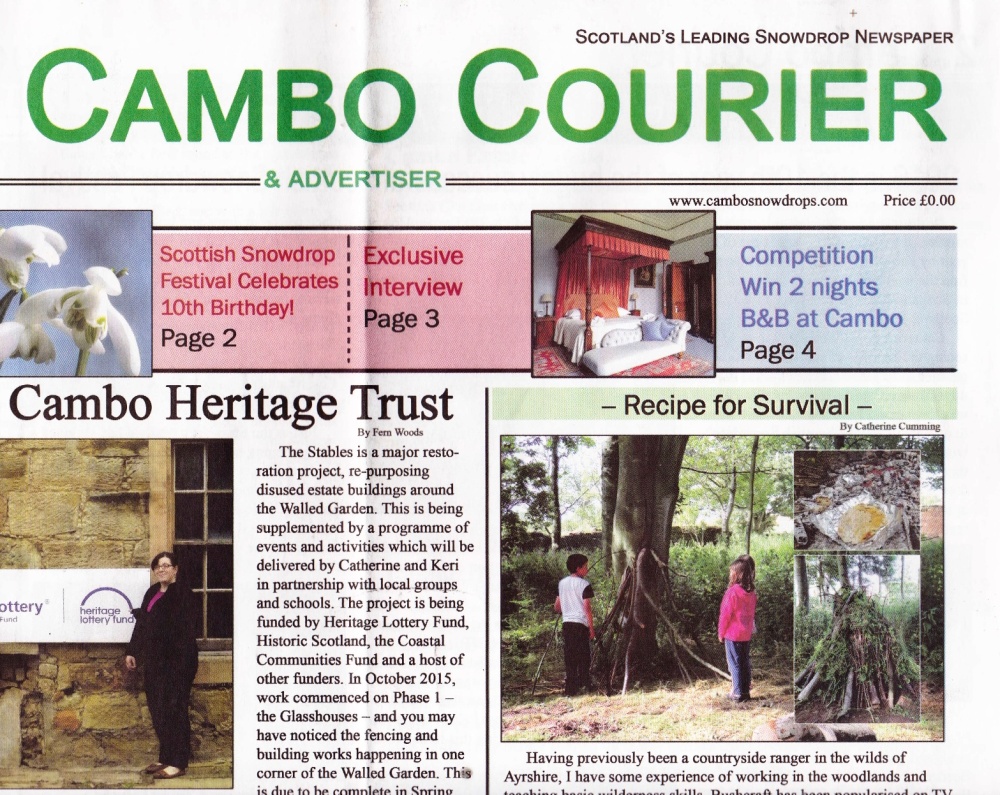
Whilst sofa bound I wander dreamily over Scottish mountainsides and remote moorland courtesy of Robert Macfarlane’s passionate book about the powerful relationship between language and place, Landmarks.
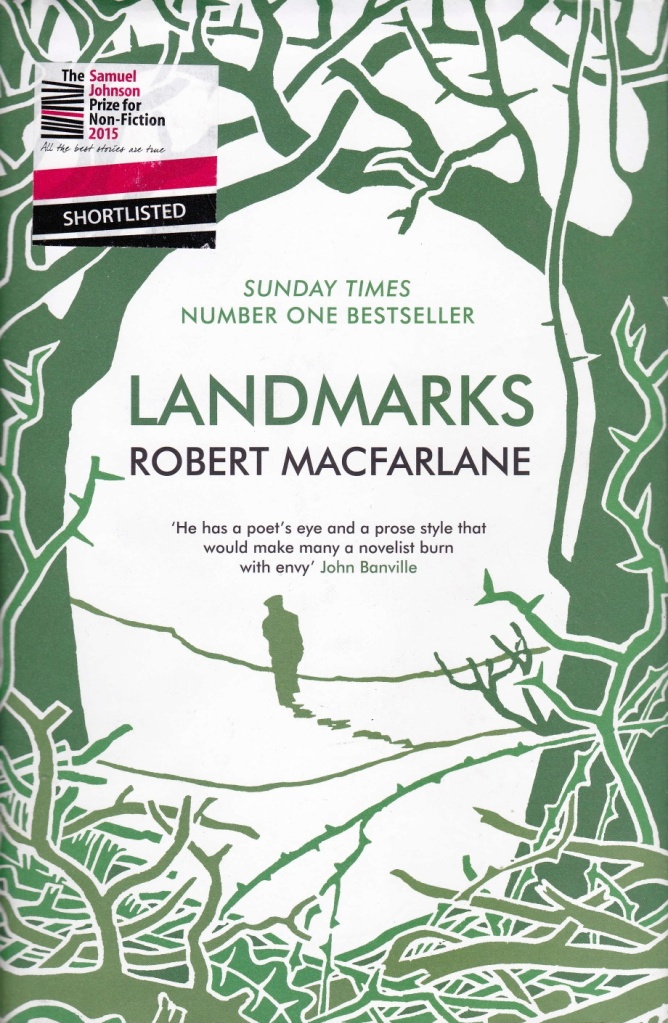
In Landmarks Macfarlane describes the work of the writers whose “books have taught me to write, but also …to see”. I am already a fan of his beloved Roger Deakin, but I am riveted by Jaquetta Hawkes, a bisexual, icy, daring, Primrose Hill academic who “knew she had had written an unclassifiable work” with her 1951 bestseller A Land – a combination of geology/anthropology/history/literature “flamboyant enough”, writes Macfarlane, “that I can imagine it re-performed as a rock opera”. Another passionate introduction is to Nan Shepherd (1893-1981) who spent hundreds of days and thousand of miles exploring the Cairngorns on foot. Macfarlane’s enthusiasm for Shepherd’s book, The Living Mountain, is intoxicating. “The Living Mountain is thick with the kinds of acute perception that come only from staying up (in a certain place) ‘for a while’. ‘Birch needs rain to release its odour’ Shepherd notes. ‘It is a scent with body to it, fruity like old brandy, and on a wet warm day one can be as good as drunk with it'”. “I had never noticed the ‘odour of the birches’ ” comments Macfarlane “but now cannnot be in a stand of birch trees on a rainy summer’s day without smelling its Courvoisier whiff”.
Threaded throughout Landmarks are collections of words – some regional, some technical, some poetic – which precisely describe an aspect of landscape in a way which stimulates and enriches. A tiny sample of my favourites:
clock-ice: ice cracked and crazed by fissures, usually brought about by the pressure of walkers or skaters, Northamptonshire.
smirr: extremely fine, misty rain, close to smoke in appearance when seen from a distance, Scots.
endolphins: swimmers’ slang for the natural opiates (endorphins) relaeased by the body on contact with cold water (Roger Deakin, poetic).
Shockingly, just as Macfarlane comes across the Peat Glossary (a treasure trove of collected terms for elements of moorland on the Isle of Lewis) he is made aware of extraordinary deletions from the new edition of the Oxford Junior Dictionary. Words “no longer felt to be relevant to a modern-day childhood” included “acorn, adder, ash, beech, bluebell, buttercup, catkin, conker, cowslip, cygnet, dandelion, fern, hazel, heather, heron, ivy, kingfisher, mistletoe, nectar, newt, otter, willow”. Replacement words included “attachment, blog, broadband, bullet-point, celebrity, chatroom, cut-and-paste”. Clearly room must be made for new terms which form part of contemporary life, but it is chilling to think that a dictionary effectively endorses the idea that a modern day child does not need to also describe an acorn, a young swan, a catkin.
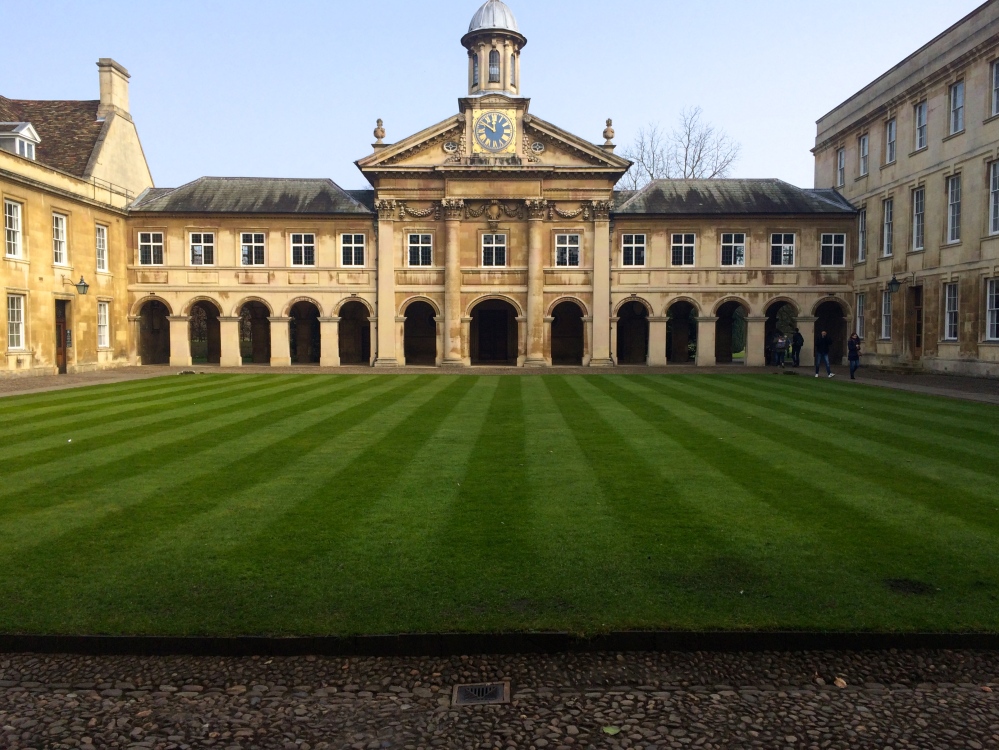 First Court, Emmanuel College, Cambridge
First Court, Emmanuel College, Cambridge
And so I find myself in the middle of March in the middle of Cambridge – I am an Open Day escort for a child who no longer uses a junior dictionary. I feel that the first place I should head once I have dropped him off is Emmanuel College for, when not roaming rainy hillsides, Dr Robert Macfarlane enjoys this immaculate and elegant environment in his role as Director of Studies for English. He happily acknowledges the irony: “Cambridge is, unmistakably, a curious place for someone who loves mountains to have ended up. I live in a country so flat (as the old joke goes) you could fax it”.
Flat it is and quite a jolt after the world of Landmarks. It is nonetheless an ordered, uplifting space and must be a brilliant place to think and work. I admire the expanses of cobbled path, the elegant yellow stone architecture and perfectly striped lawn. I am particularly taken by these stone curlicued lawn corners:
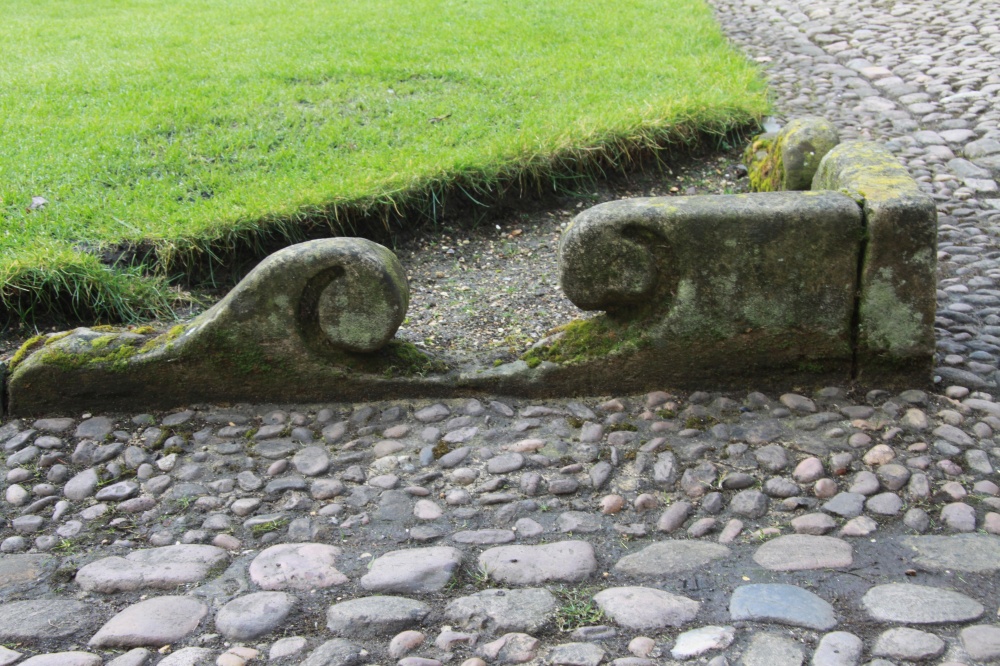
Decorative stone lawn corners
A serene colonnade divides First Court from the extensive gardens beyond but – despite the luxury of green space/benches/ponds – I am disappointed by a slightly heavy, municipal gardening style after the crispness of the first courtyard.
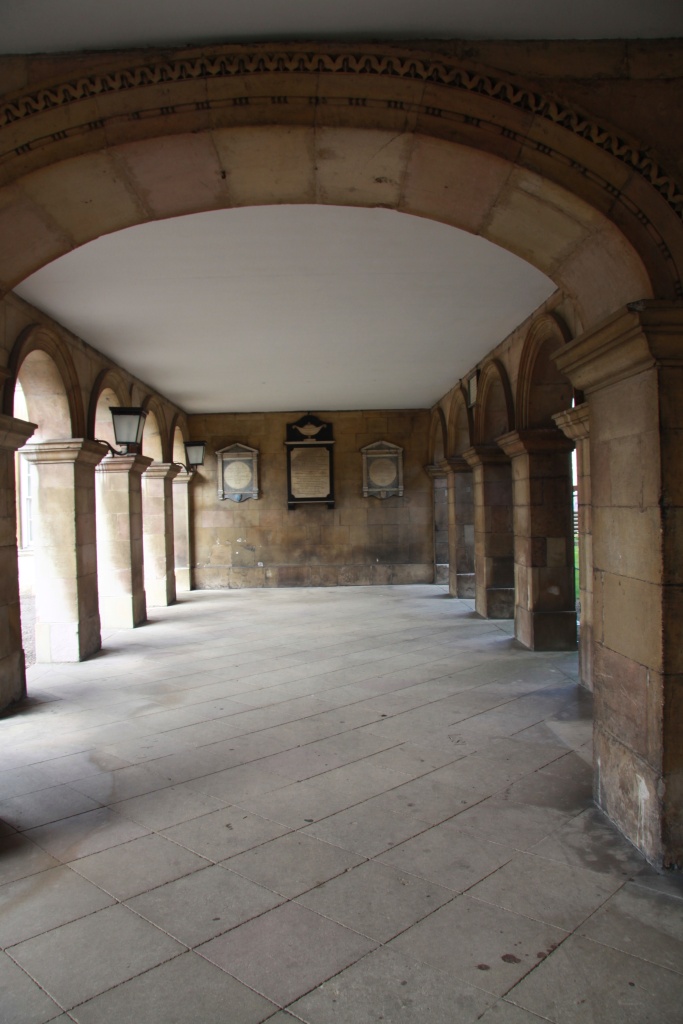 Emmanuel College, colonnade
Emmanuel College, colonnade
There is a moment of sugary prettiness – low-slung pink cherry, pink bergenia, and darker pink hellebore (plus white van):
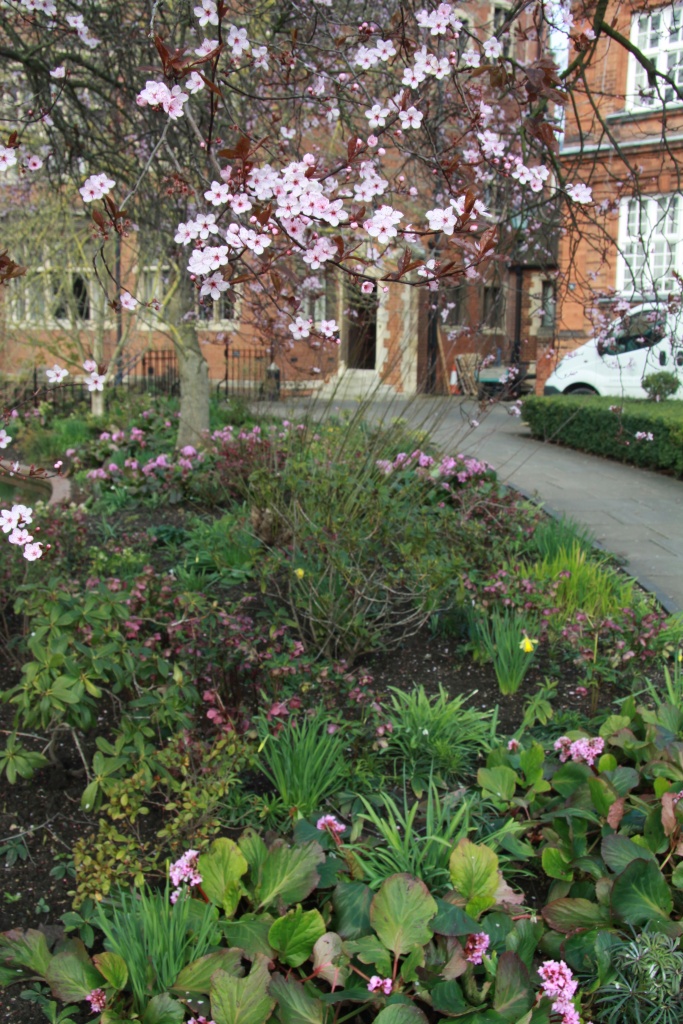 Pink cherry, bergenia and hellebore
Pink cherry, bergenia and hellebore
And across the pond, bright white silver birch trunks and the ornamental plum blossom – Prunus cerasifera – make a handsome pair – but the rest could be a park pretty much anywhere.
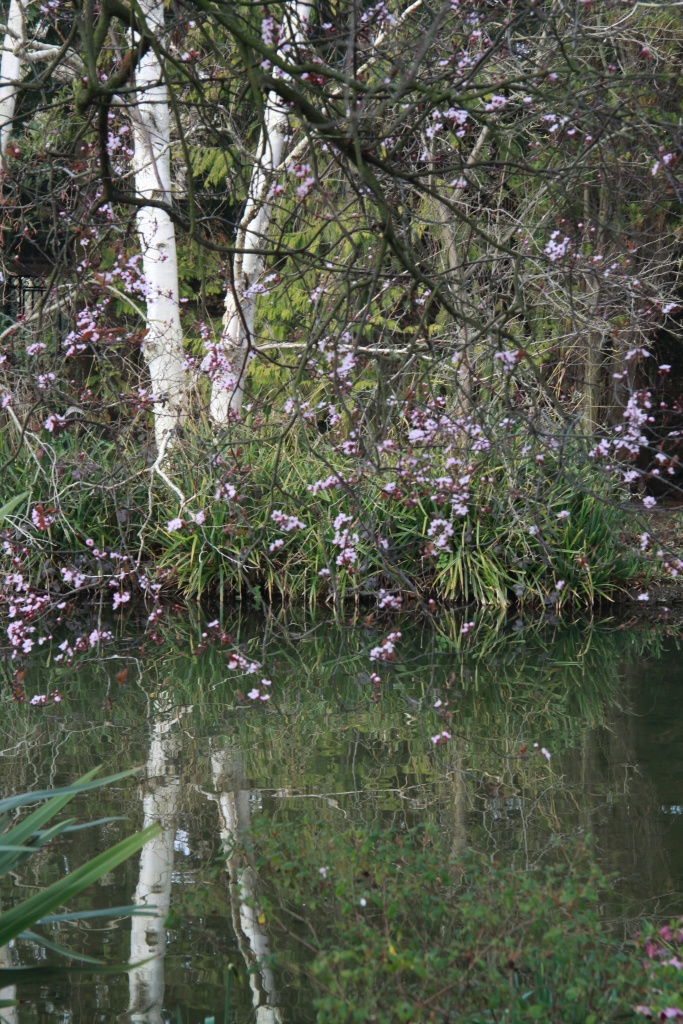
I am happier in the First Court of Christ’s College – a masterclass in training plants perfectly to cloth buildings. None of the plants are unusual, but they are all grown very well and work hard to add another layer of texture and life to their privileged framework.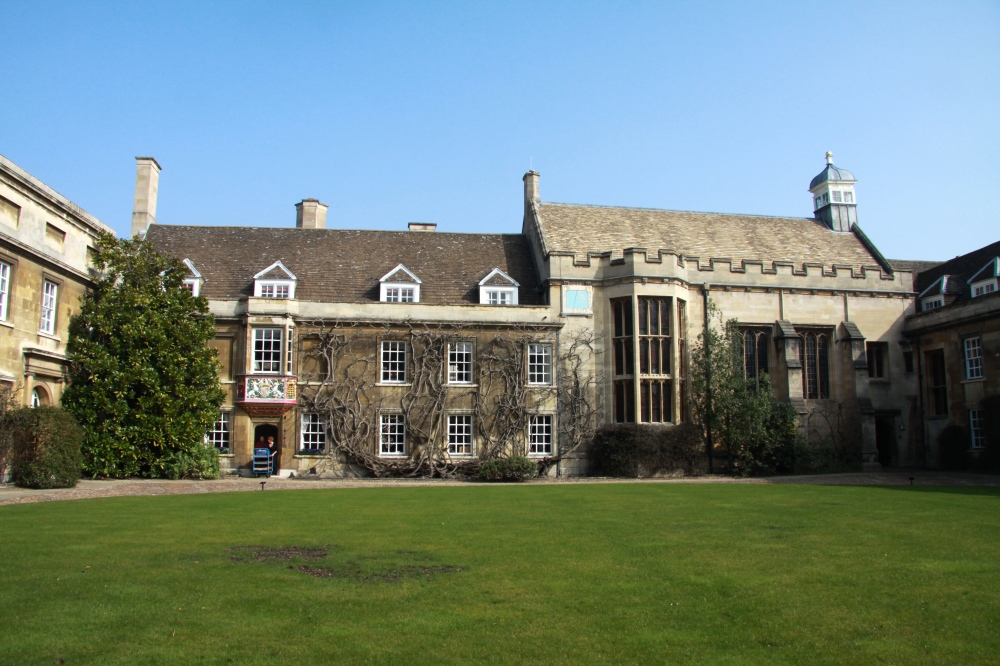 First Court, Christ’s College, Cambridge
First Court, Christ’s College, Cambridge
Here a ballgown of a Magnolia grandiflora bulges glossily in the corner adding light and evergreen richness to the scene. To the right of the doorway a gnarled, sculptural wisteria frames a set of eight windows and will look spectacular in a few weeks’ time. 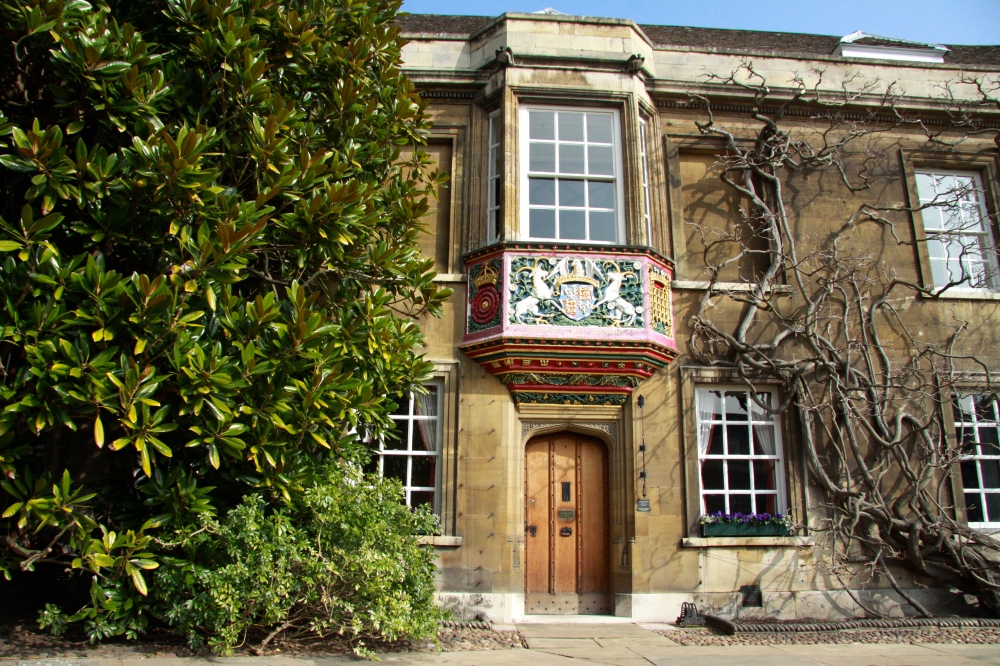 Magnolia grandiflora and wisteria, Christ’s College, Cambridge
Magnolia grandiflora and wisteria, Christ’s College, Cambridge
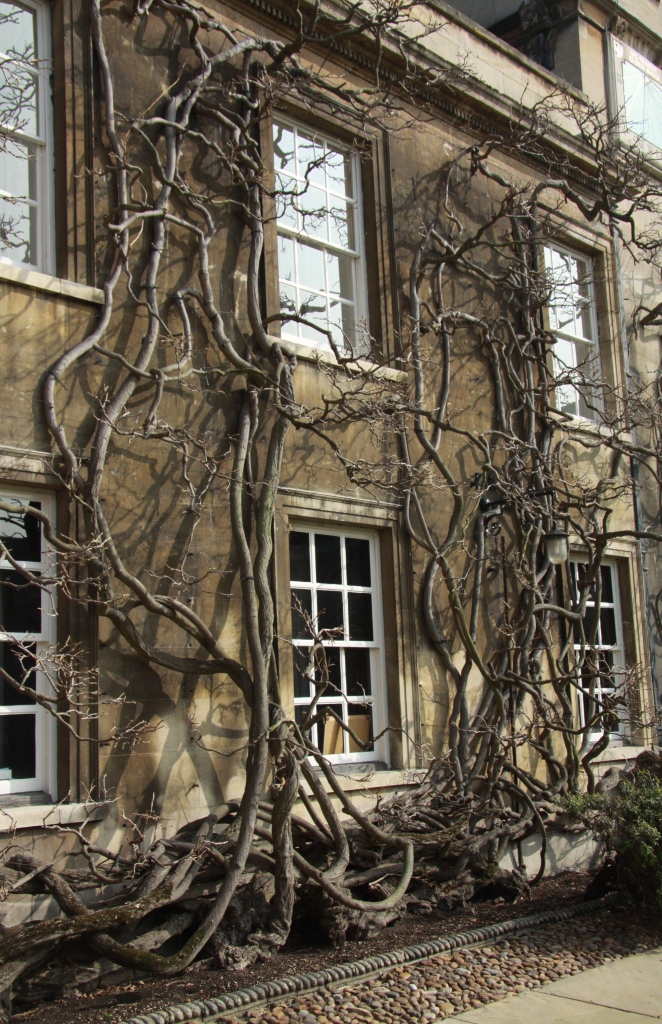 Trained wisteria, First Court, Christ’s College Cambridge
Trained wisteria, First Court, Christ’s College Cambridge
On a shadier wall a Hydrangea petiolaris is a chunky three dimensional presence framing a pair of windows. The feisty, surprisingly long, green buds are just beginning to smatter the russet mass of branches with dashes of bright green.
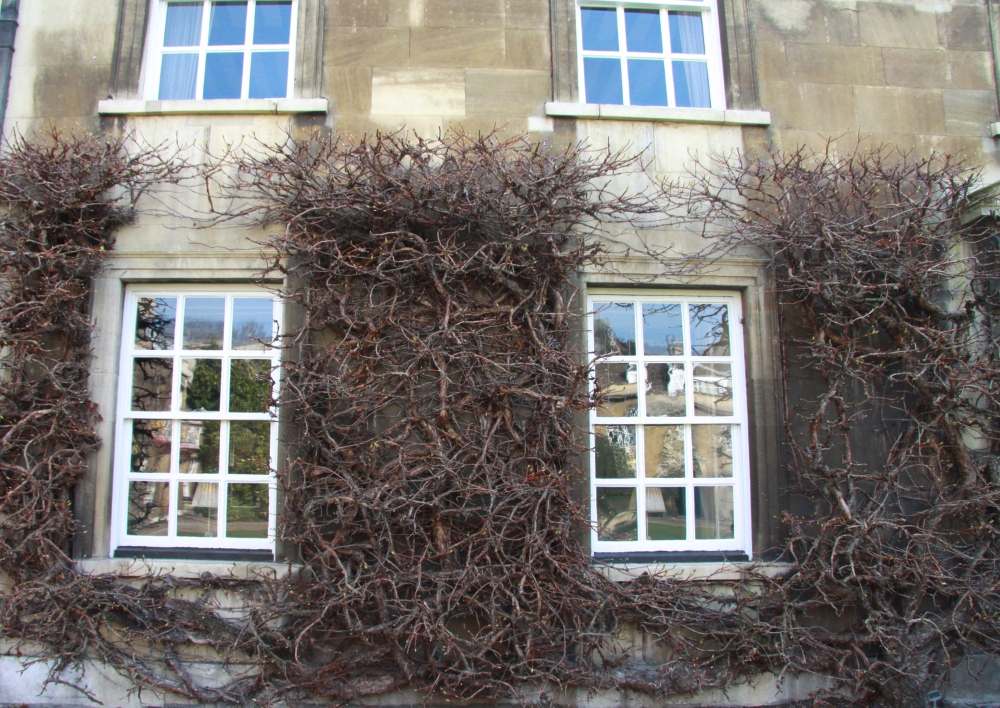
On the opposite wall a Jasminum nudiflorum looks great too – shaggy, green-stemmed and dancing with illuminating star-shaped yellow flowers:
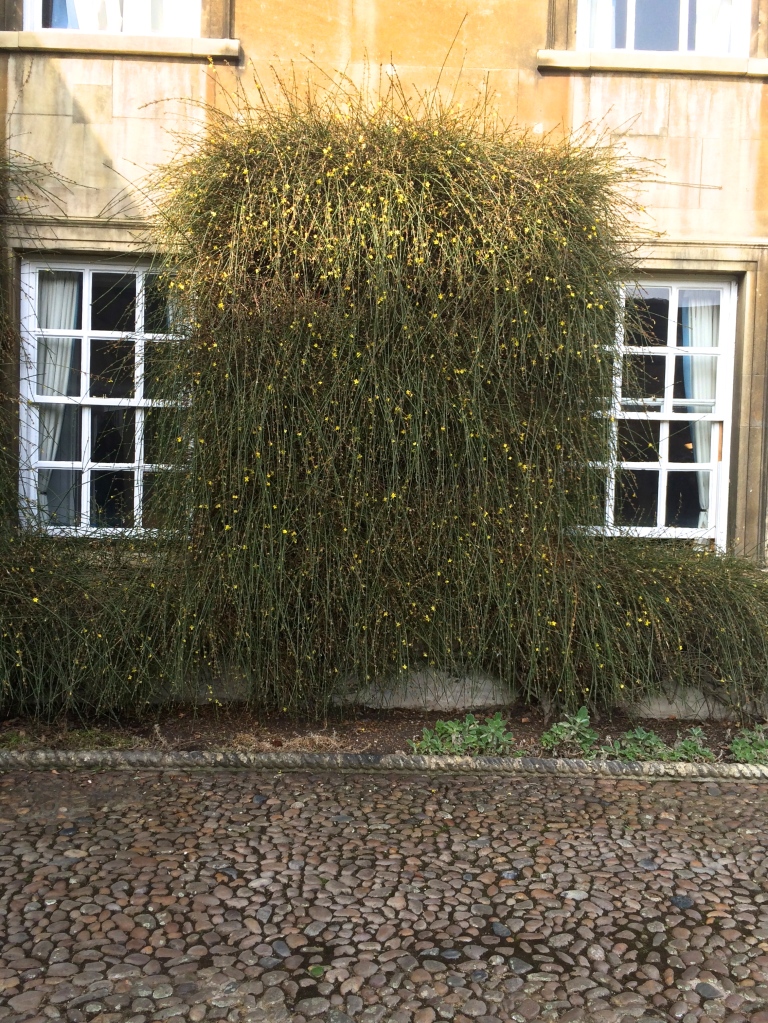
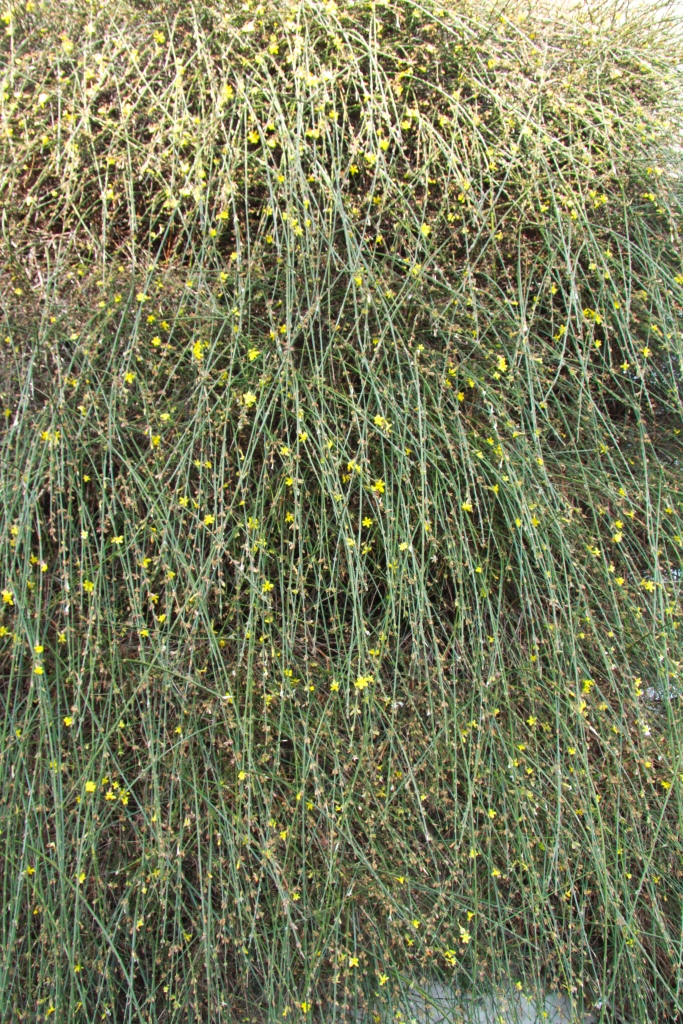
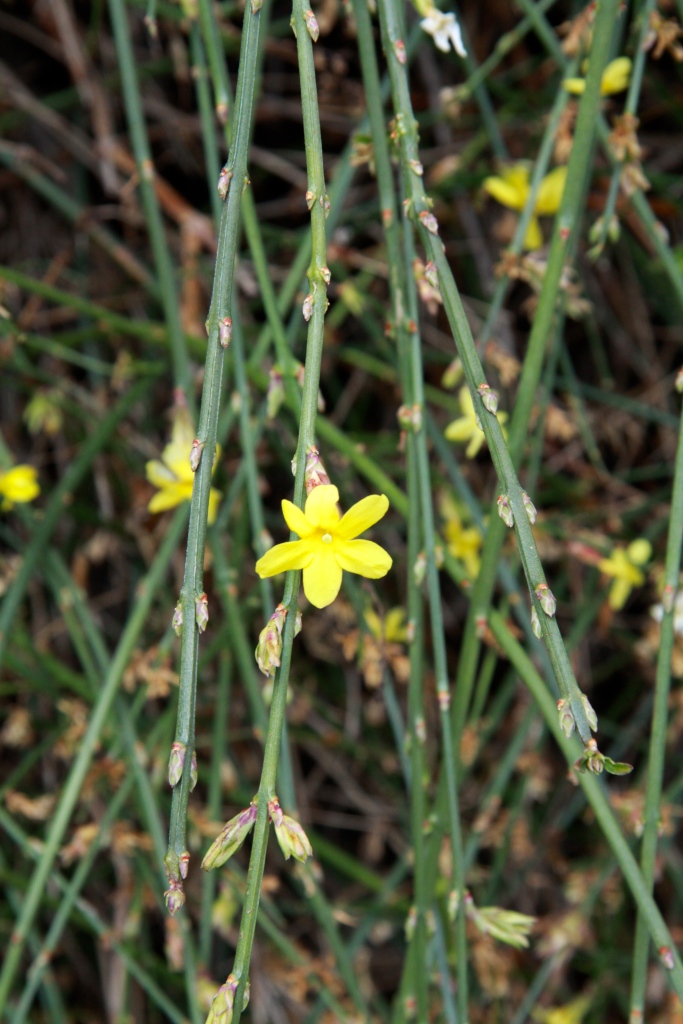
Jasminum nudiflorum, Frist Court, Christ’s College, Cambridge
And further along a hard pruned wall-trained Chaenomeles – flowering quince – is beginning to glow with scarlet flowers:
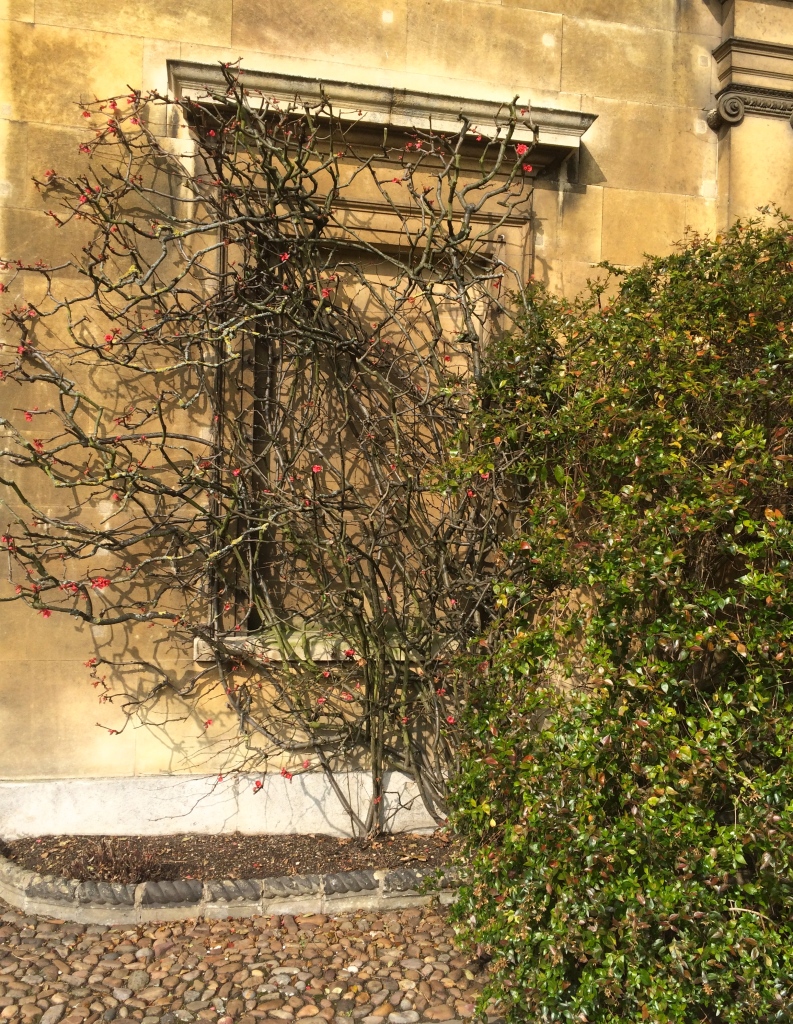
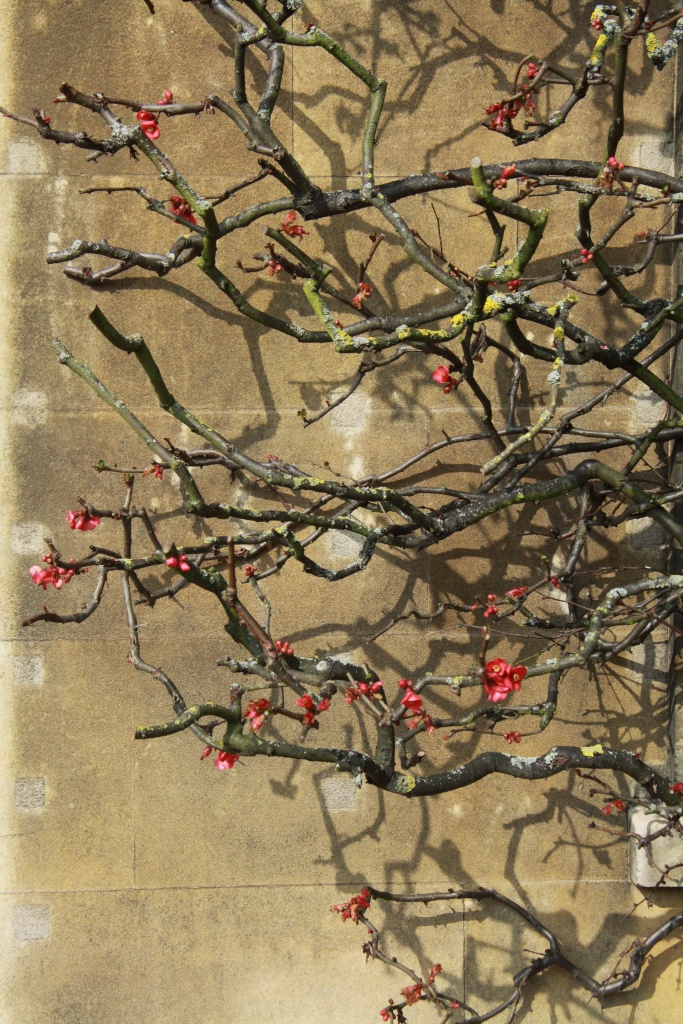 Wall trained Chaenomeles – flowering quince, First Court, Christ’s College, Cambridge
Wall trained Chaenomeles – flowering quince, First Court, Christ’s College, Cambridge
Perhaps my favourite of the wall trained plants is this delicate Abutilon ‘Kentish Belle’. The apricot flowers from red calyces really do add tiny points of light to their sober stone backdrop. ‘Kentish Belle’ will only ever grow to about 3 metres, probably less, and is semi evergreen. It should flower from June to November but, in a sheltered position like this, will hold onto its leaves and flower perpetually. A not particularly fashionable plant – but one we should definitely use more often.
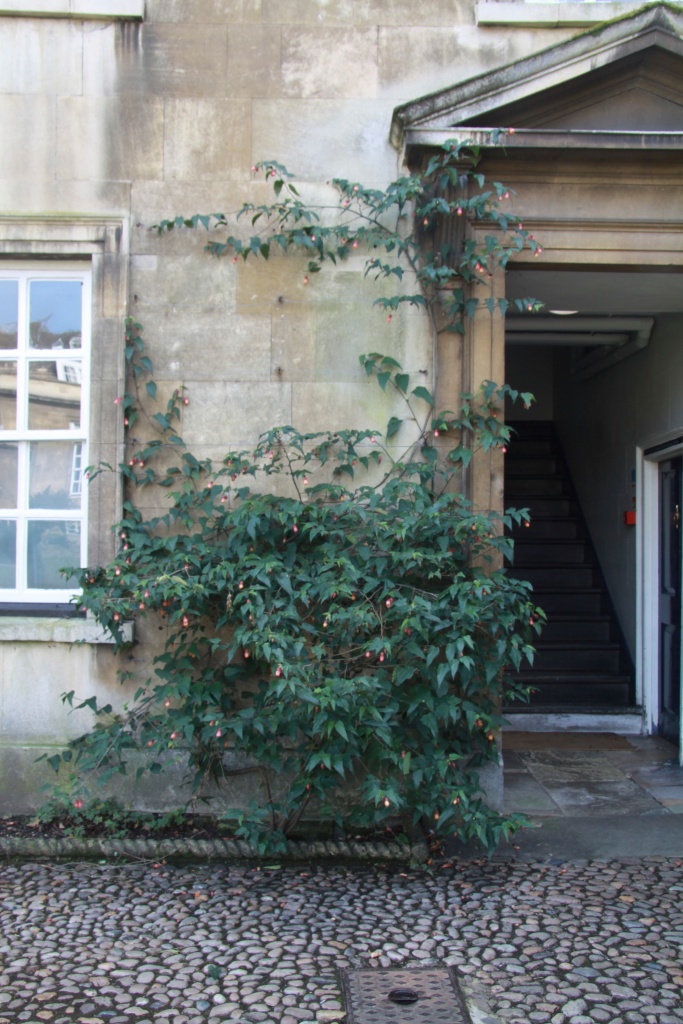
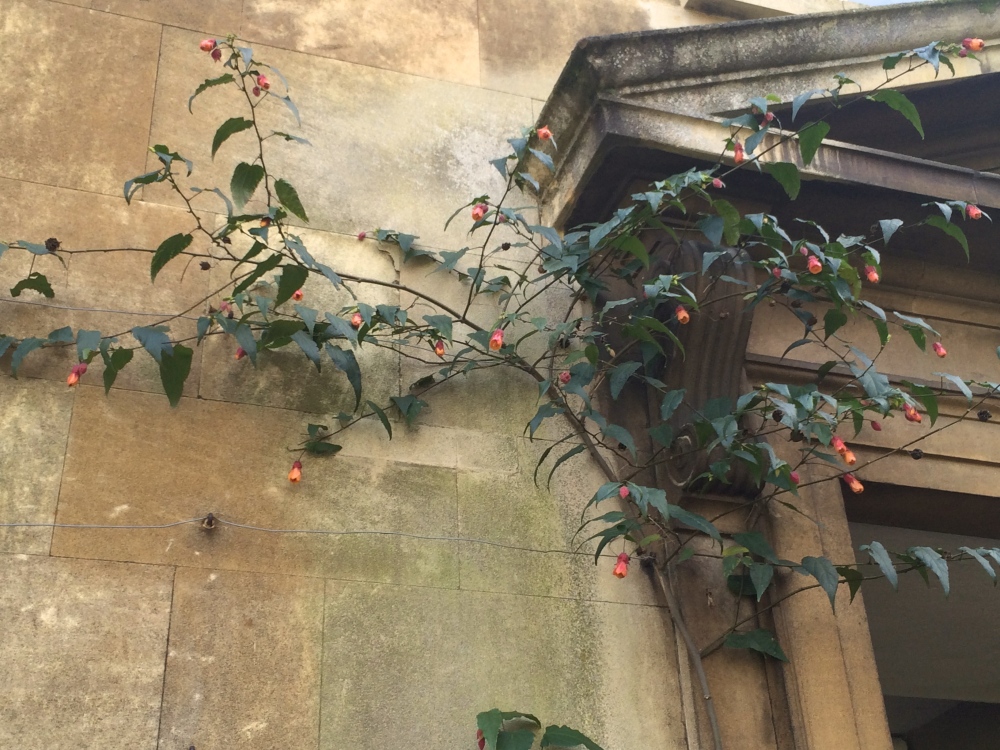
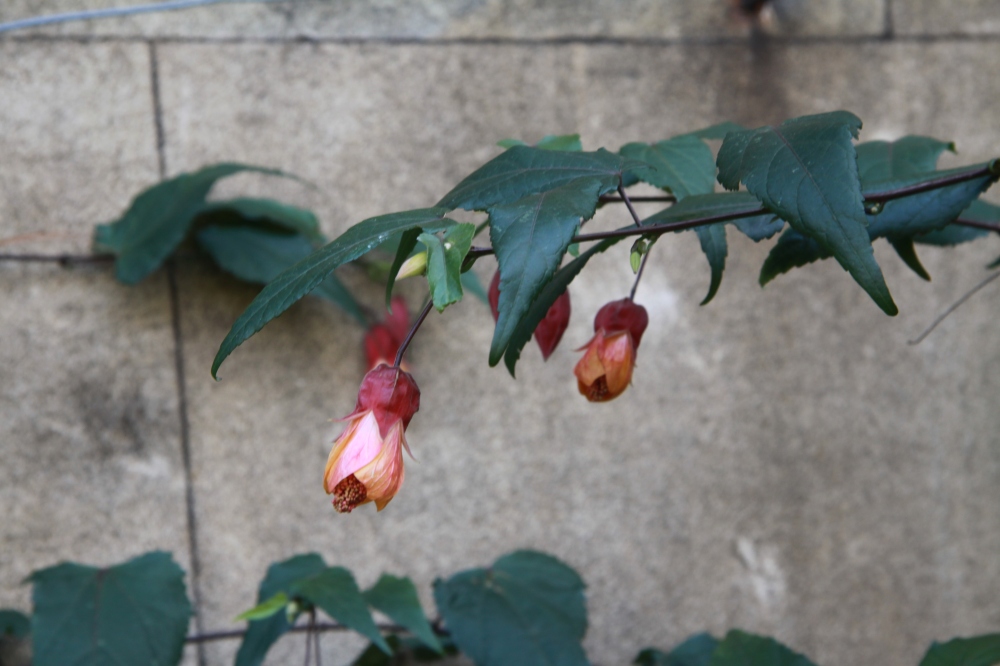
Abutilon ‘Kentish Belle’, First Court, Christ’s College, Cambridge.
I nip into Pembroke College. Most of the garden is looking hard-pruned and shut down until spring, but I like the wave-like mounding shrubs that form a run against the Chapel wall and note the classic combination of Viburnum davidii and Sarcococca hookeriana var. digyna that nestle so comfortably around the sculpture of William Pitt.
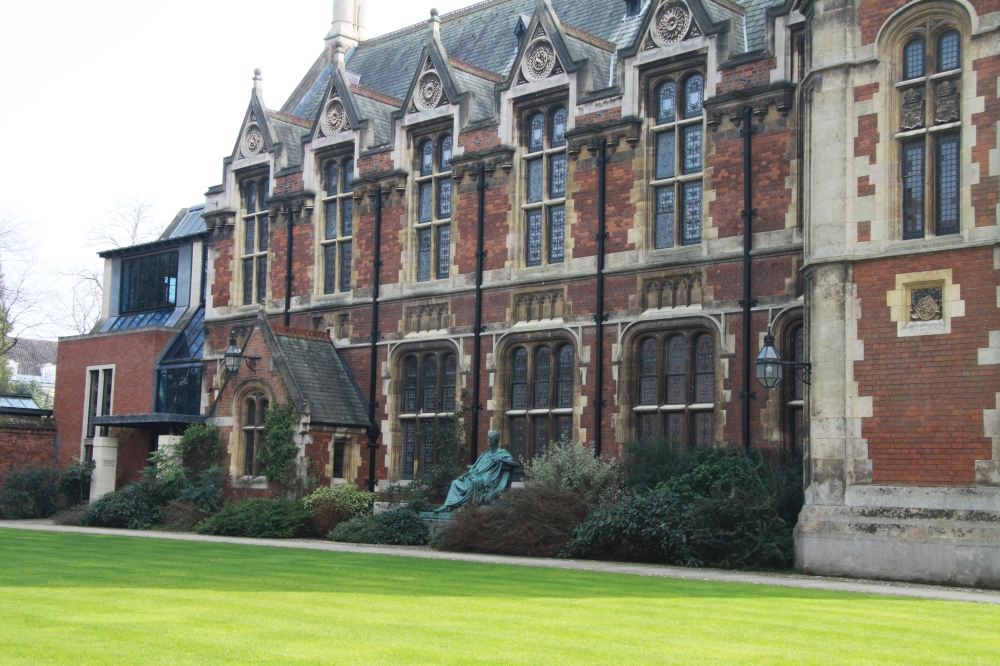
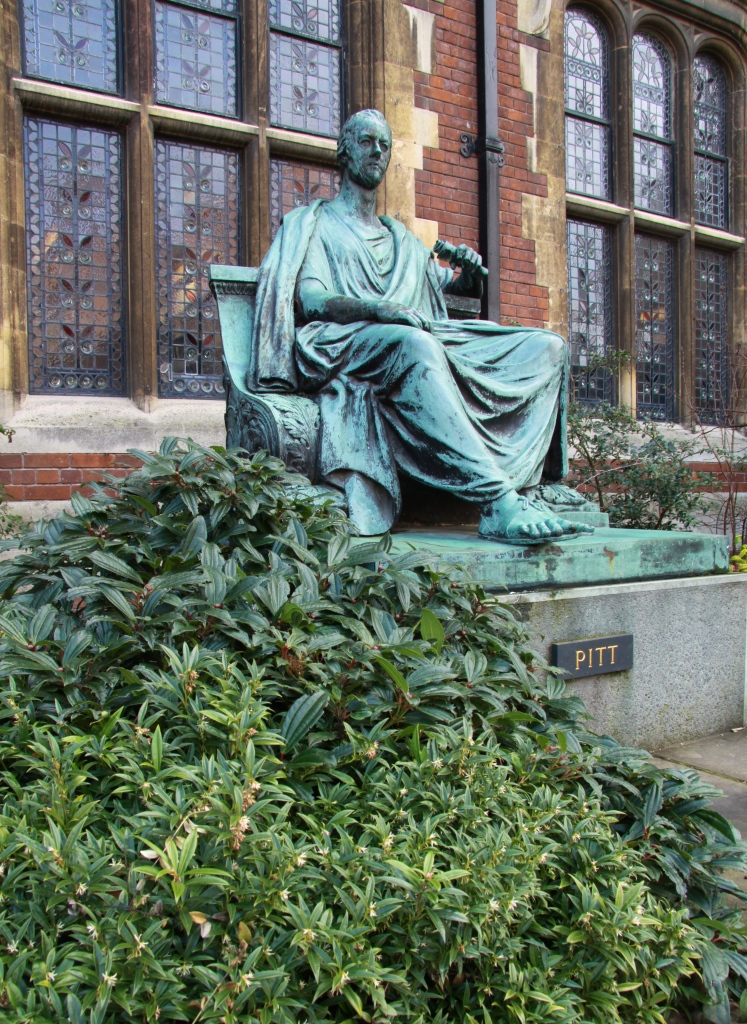
Pembroke College Chapel with close up of Vibrunum davidii and Sarcococca hookeriana at the base of the Pitt sculpture.
I walk over to Clare just to admire the brilliant bulb-spangled grass verges that I know will be there. I am not disappointed. As well as the neatest sheafs of Narcissus ‘February Gold’, there are crocus, powder blue Anemone nemerosa ‘Robinsoniana’ and the richer royal blue of the tiny star shaped, Chionodoxa lucilae. Of the latter, Christine Skelmersdale of specialist bulb suppliers Broadleigh Bulbs, writes “in the spring tapestry there has to be something to tie it altogether and these little bulbs do just that”.
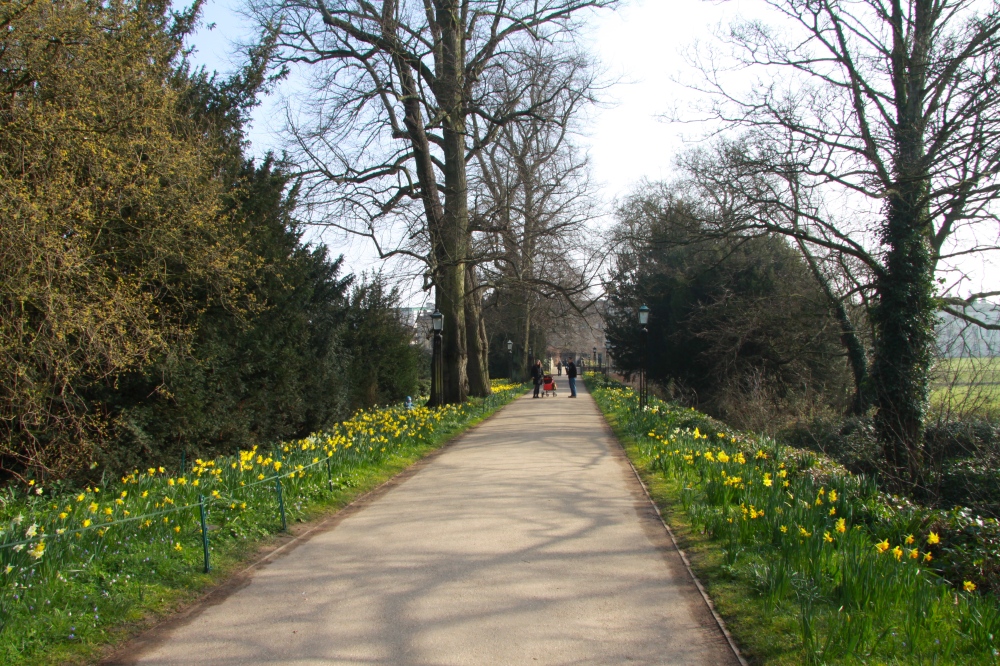
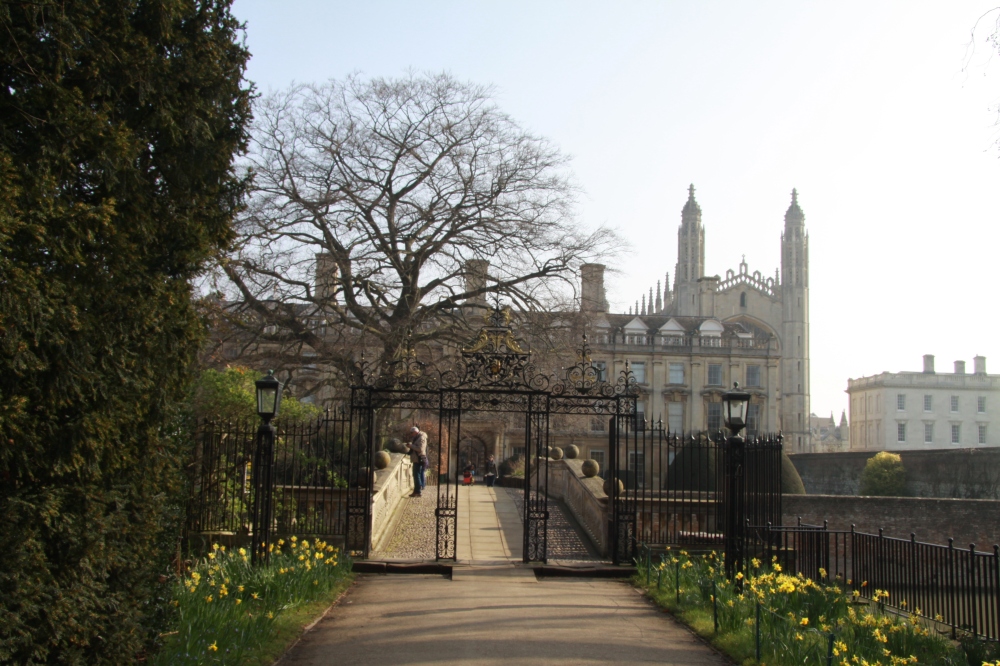
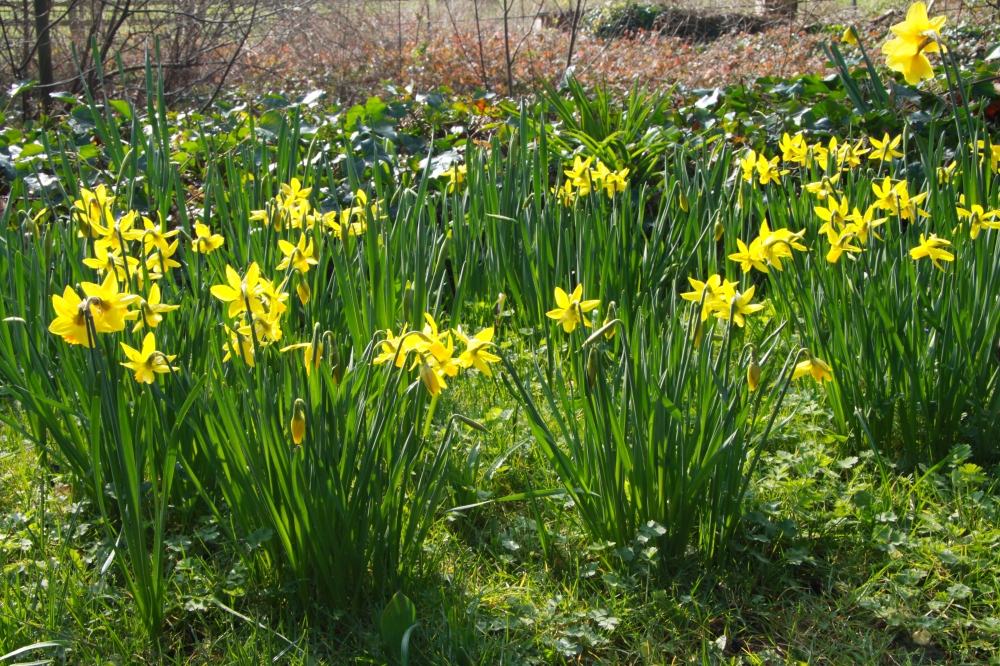
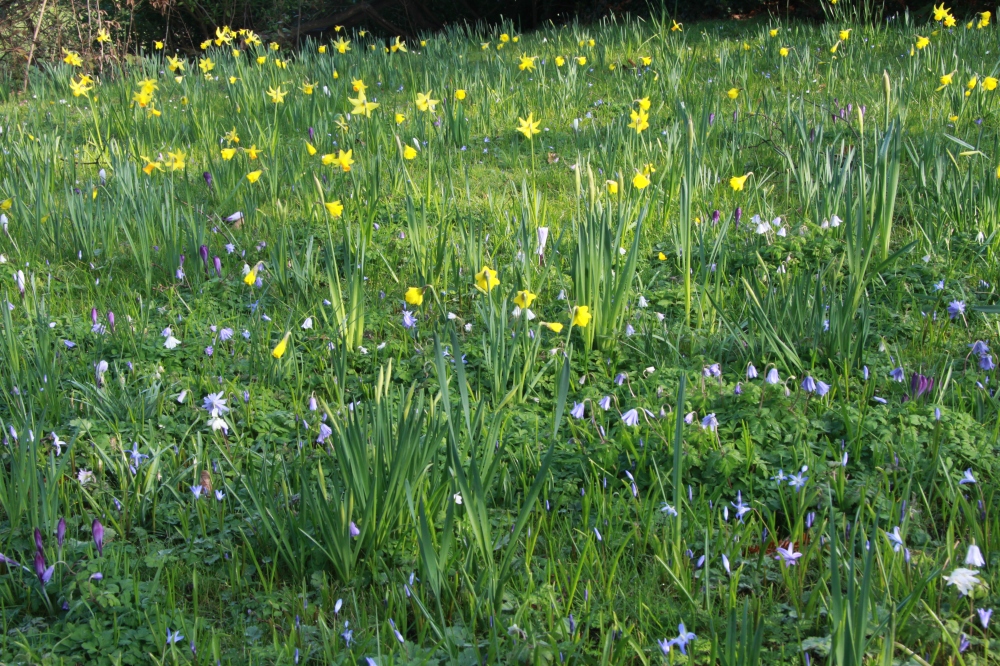
Path leading to Clare College, Cambridge with bulb rich grass verges on either side
I am smitten yet again by the elegant stone balustrade and cobbled shadows of Clare College Bridge in combination with the two razor-sharp yew domes of the Scholars’ Garden beyond.
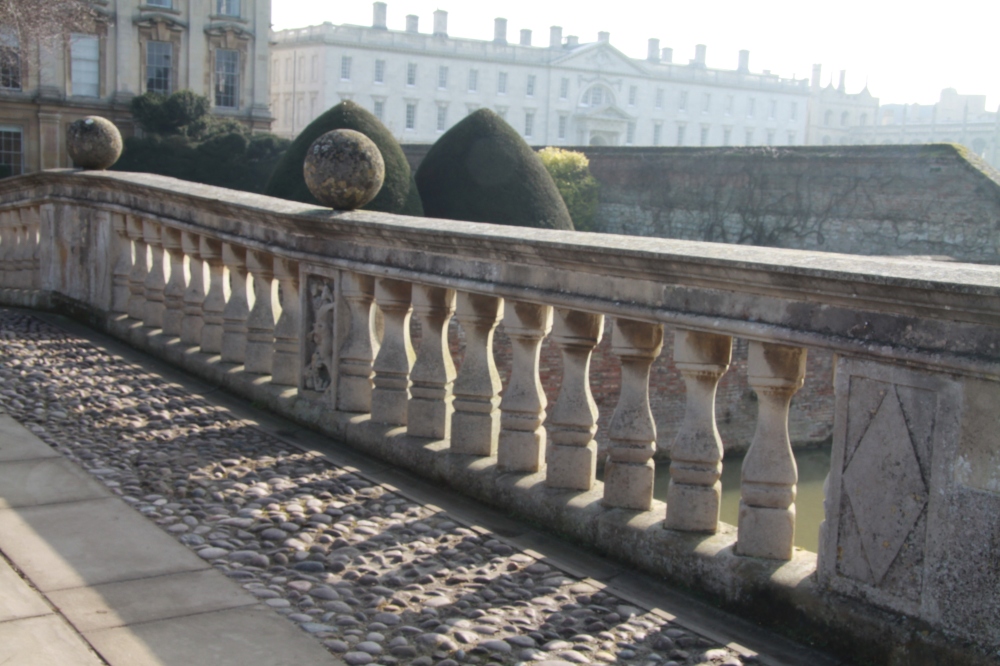
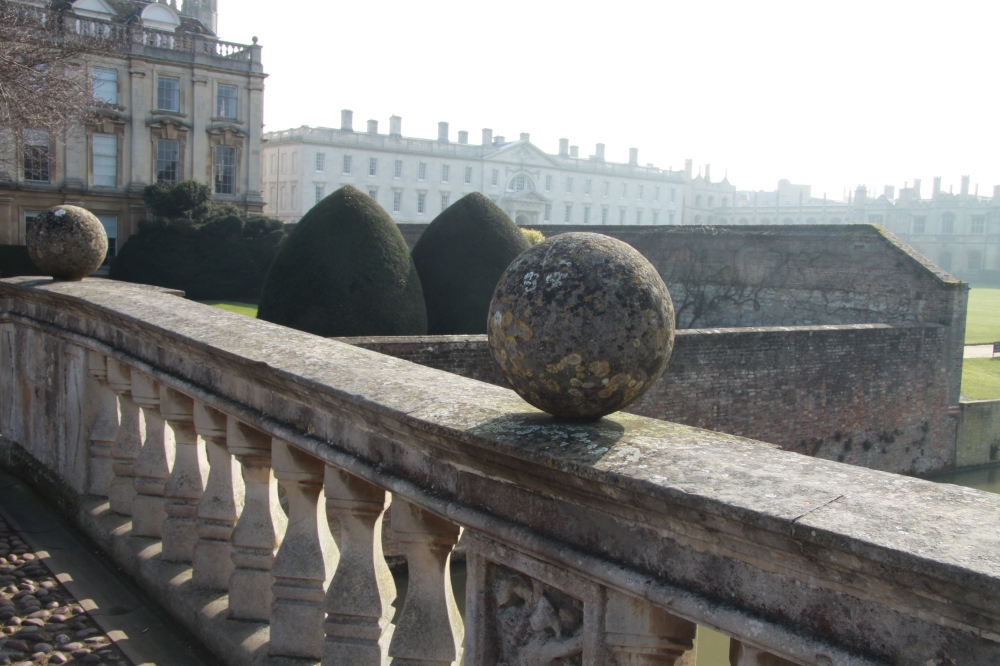 View across Clare College Bridge to the Scholars’ Garden
View across Clare College Bridge to the Scholars’ Garden
Peering into the Scholars Garden itself the yews continue to be a distinguished and brilliantly sculptural presence. I ache slightly to be here so early in the year. The borders are prepared and mulched and just waiting for the seasons to progress: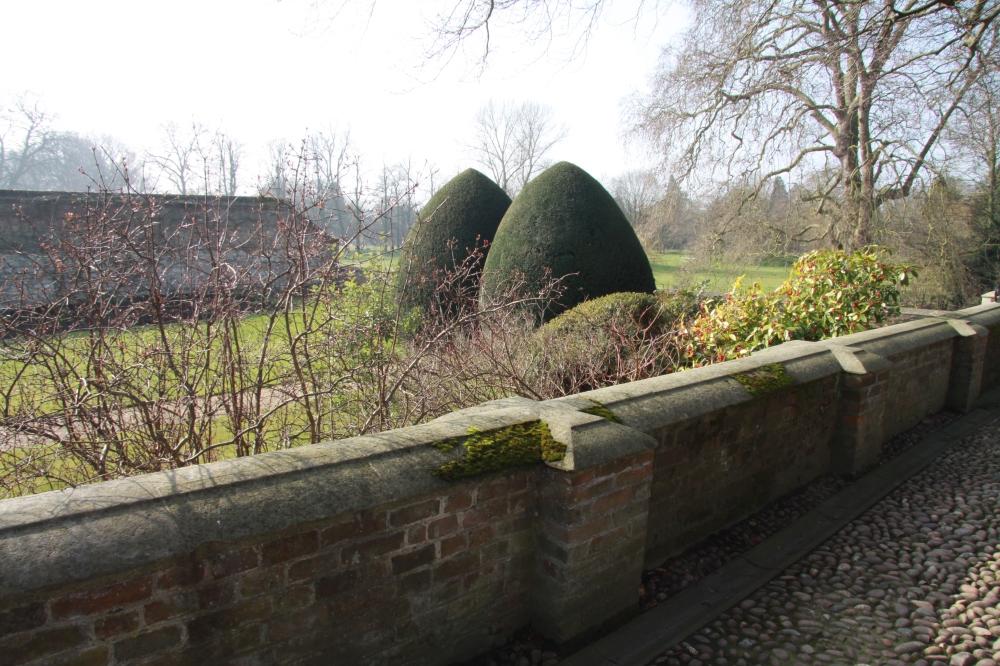
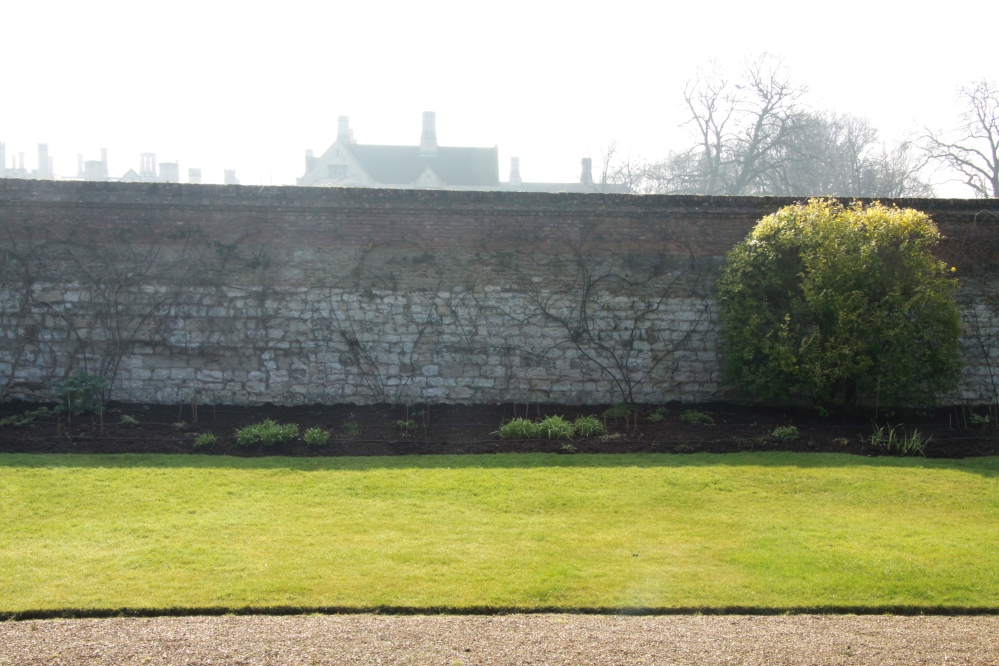 Scholars’ Garden, Clare College, Cambridge
Scholars’ Garden, Clare College, Cambridge
My walk takes me past a tree that fills the shadowy space between the west end of King’s College Chapel and the wrought iron gates. The tree is Prunus ‘Taihaku’ – the great white cherry. Sarah Raven wrote an excellent piece for The Telegraph about this tree in 2001. Her father was a don at King’s and she describes the way the tree “glows” with its ‘”huge, pure white, straight-edged flowers … as if lit from inside”. For now the tree is a hardened winter network of fine branches which play lightly against the lacy architecture of King’s Chapel. It is exciting to think of the transformation of this space next month.
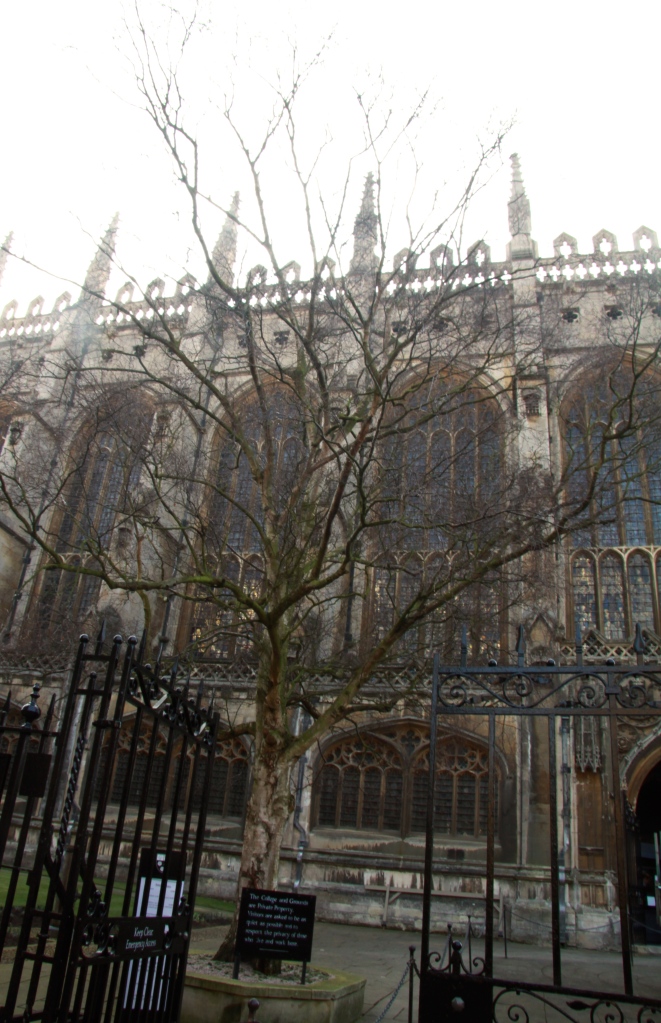
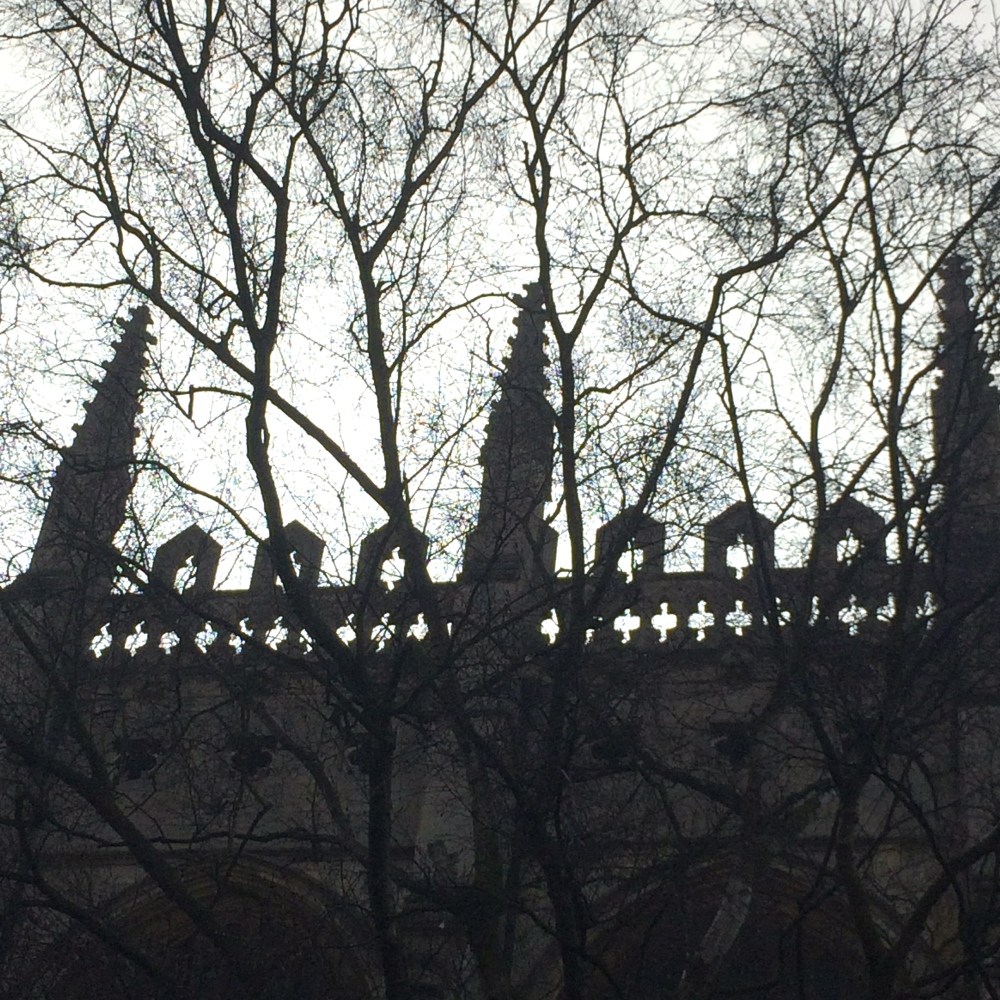 Prunus ‘Taihaku’ against King’s College Chapel, Cambridge
Prunus ‘Taihaku’ against King’s College Chapel, Cambridge
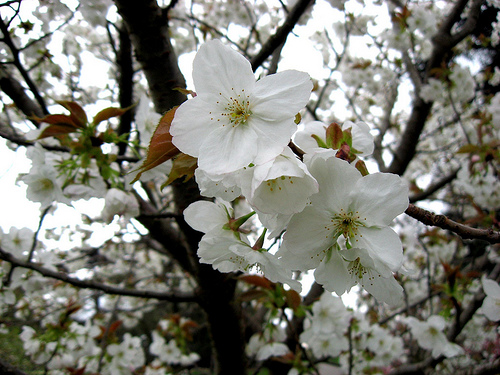 Prunus ‘Taihaku’ flowers
Prunus ‘Taihaku’ flowers
From this point on, Cambridge is at its headiest with brilliantly different architectural styles coming at you from every direction. I walk past the intricate, sandy-stoned, 16th Century Gate of Honour belonging to my old college, Gonville and Caius:
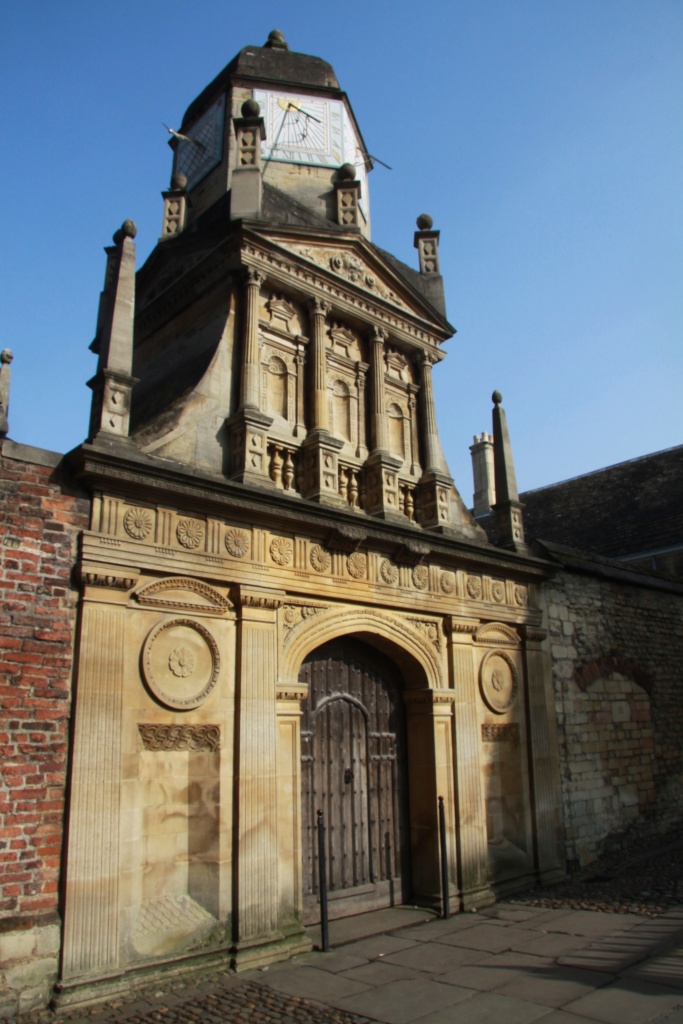 Gate of Honour, Gonville and Caius College, Cambridge
Gate of Honour, Gonville and Caius College, Cambridge
In huge contrast is the neighbouring Senate House – formal, white, austere with a completely plain lawn and vast Roman Urn – a 19th Century bronze copy of the ‘Warwick Vase’ from Hadrian’s Villa Tivoli. I smile at the extremely neat, elongated shadow the urn casts on the enormous lawn:
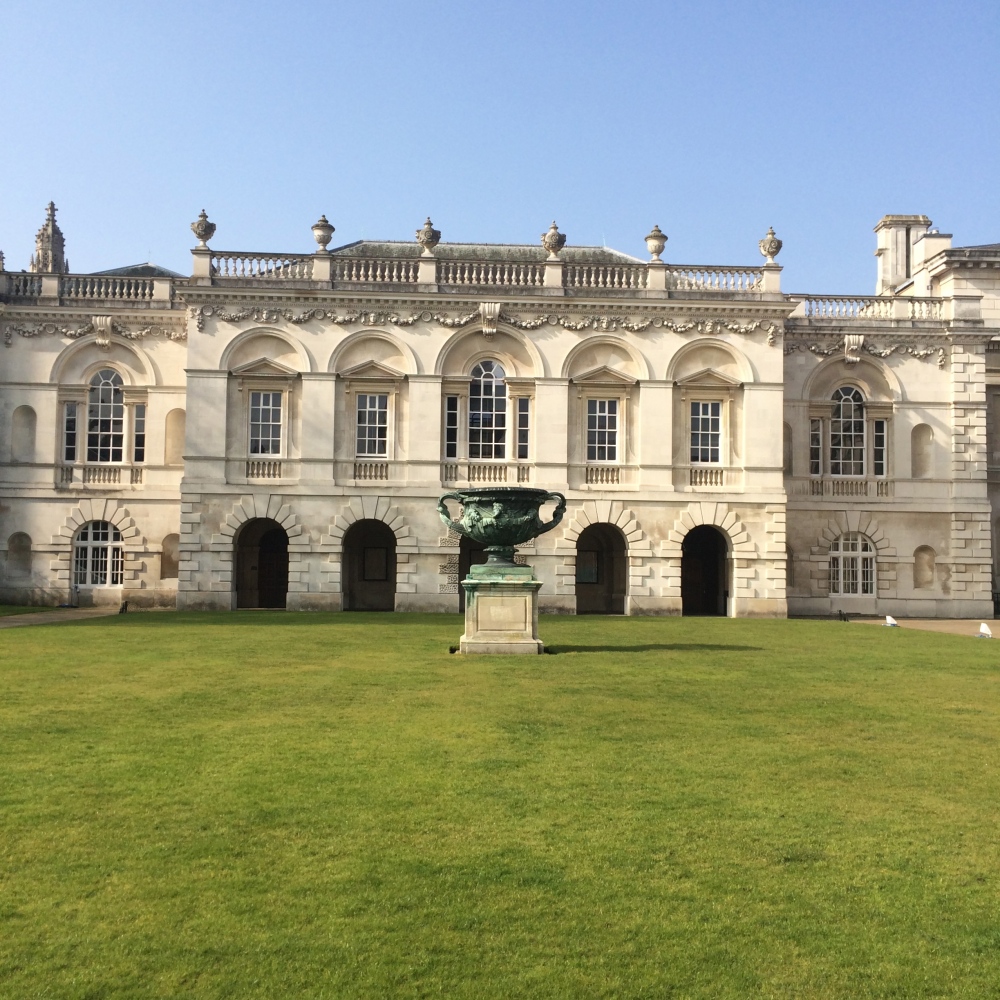
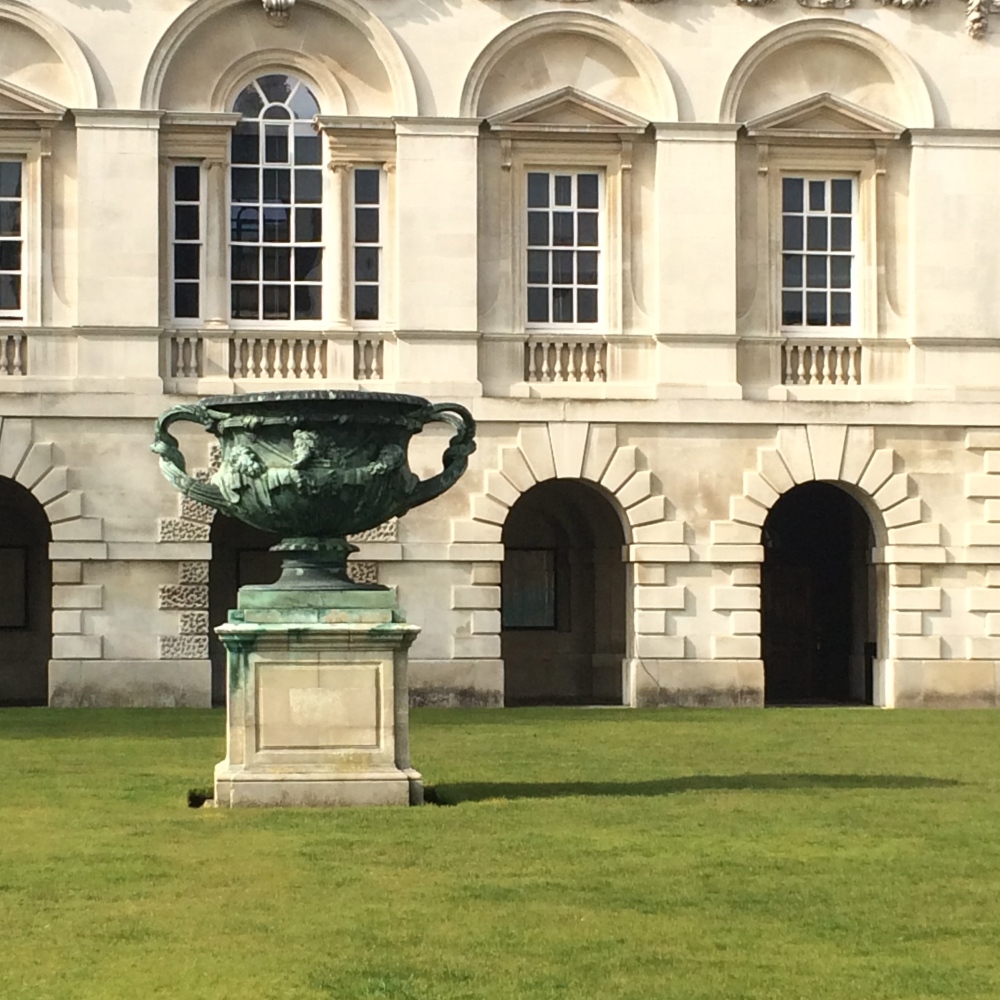 Senate House, Cambridge, with Bronze copy of the Warwick Vase
Senate House, Cambridge, with Bronze copy of the Warwick Vase
Immediately next to this, the looming shape of King’s College Chapel is perfectly echoed by the surging dome of a two hundred year old horse chestnut tree. A magnificent pair when the horse chestnut is in its skeletal winter guise, but how much lovelier when the chestnut is in leaf and laden with its candle-like flowers?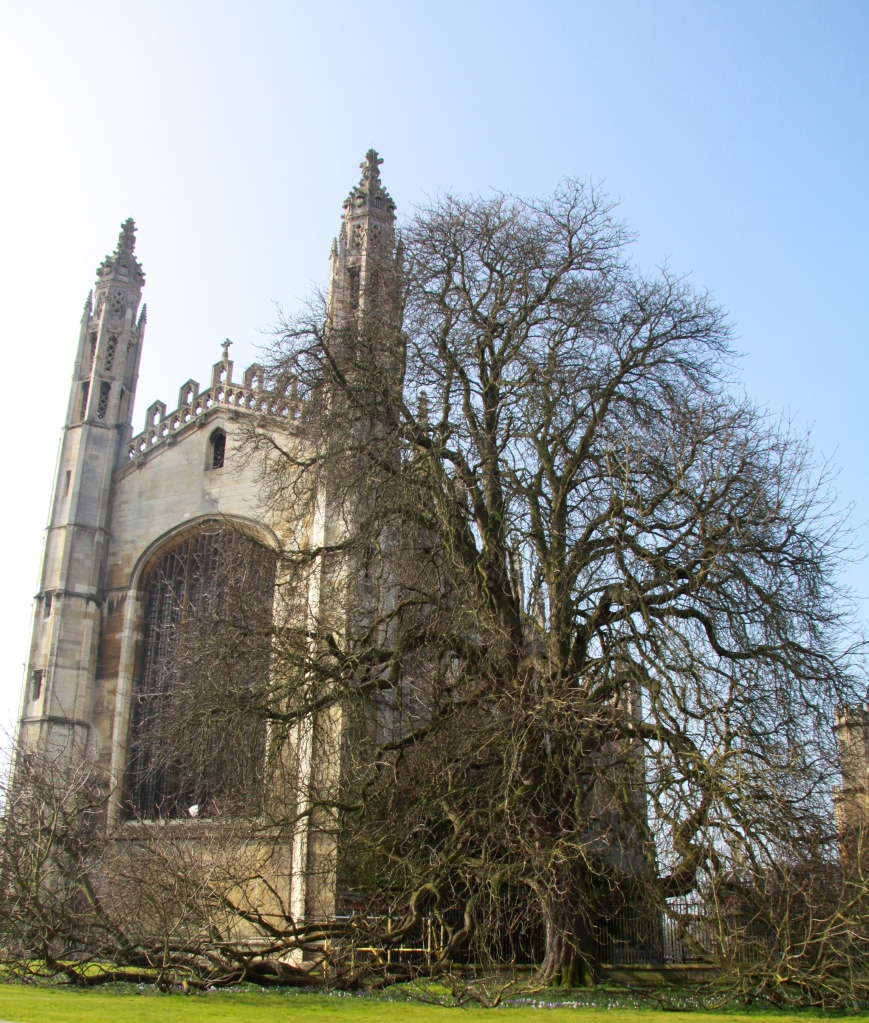
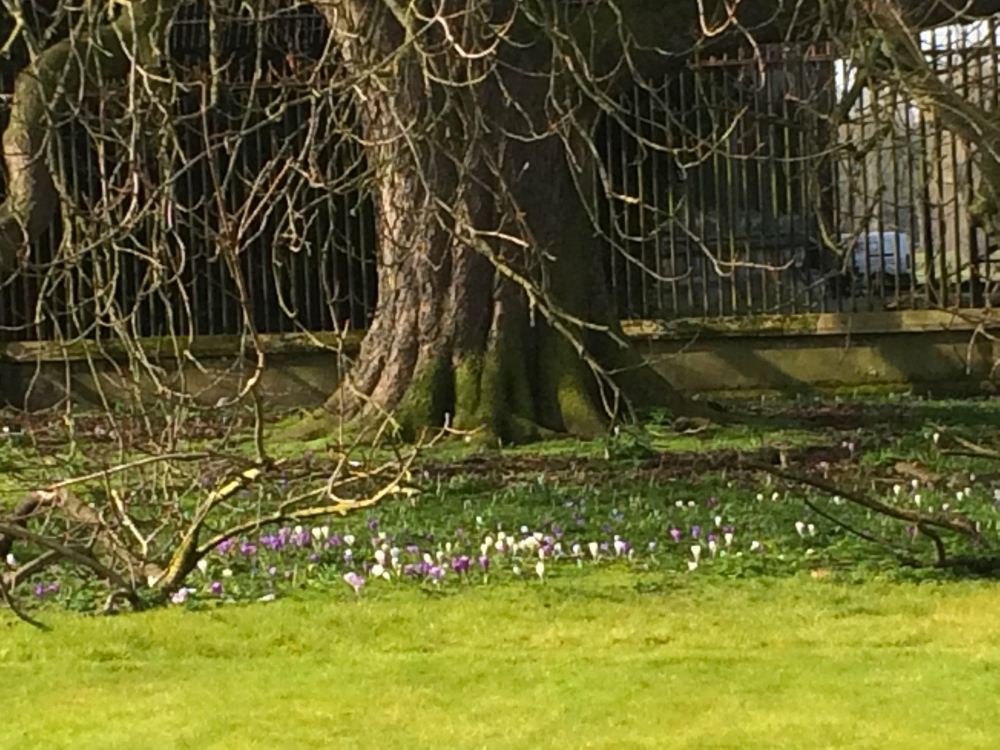 Kings College Chapel and Horse Chestnut tree
Kings College Chapel and Horse Chestnut tree
I head to the Fitzwilliam Museum – just to turn the screw a little on the memory lane experience – but before I go in I am thrown by the outrageously glamorous green and gold pineapple railings which guard the stone balustraded entrance. Had I really never noticed these before? I am relieved to discover that the railings were only repainted in their “original livery of bronze green with 23.5 carat gold leaf ornaments” in 2014 having been quietly painted black for decades. The railings, I tell you, are now some of the finest you will ever have the pleasure to see.

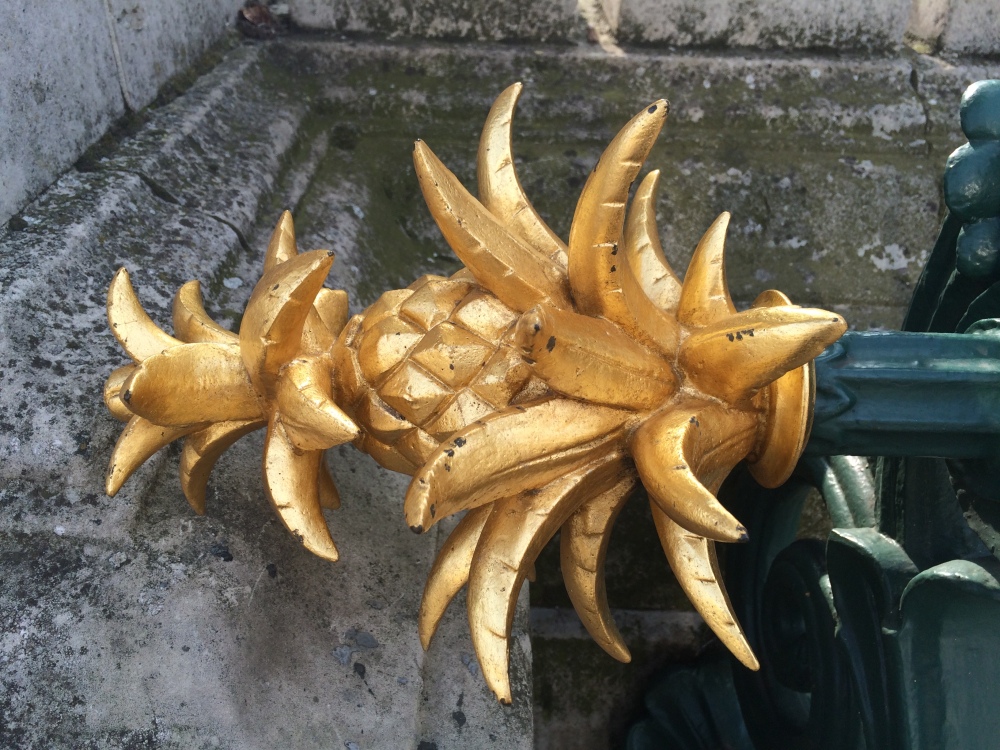
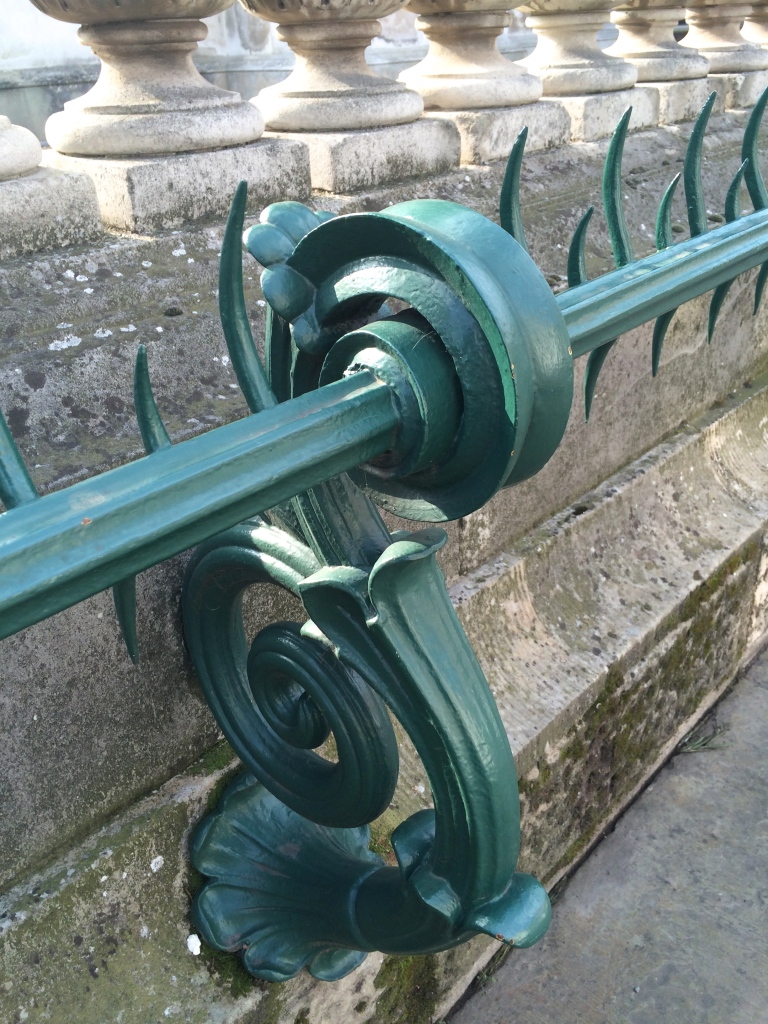 Bronze green and 23.5 carat gold railings, Fitzwilliam Museum, Cambridge.
Bronze green and 23.5 carat gold railings, Fitzwilliam Museum, Cambridge.
I have just enough time to step into ‘Crawling with Life: Flower Drawings from the Henry Rogers Broughton Bequest’. The exhibition is held in an enclosed cabinet-like exhibition space and contains just a small number of exquisite 17th and 18th Century drawings of flowers – with their accompanying insects.
There is a feeling of dark playfulness in the air – it is like entering a sedate drawing room where you discover that no one is quite as respectable as they initially seem to be. Jacob Marel’s ‘Venetian Glass Goblet with Flowers and Insects’ is radiant with spring colour but the jewel-like insects which lace themselves slightly secretively throughout the composition have an unsettling effect.
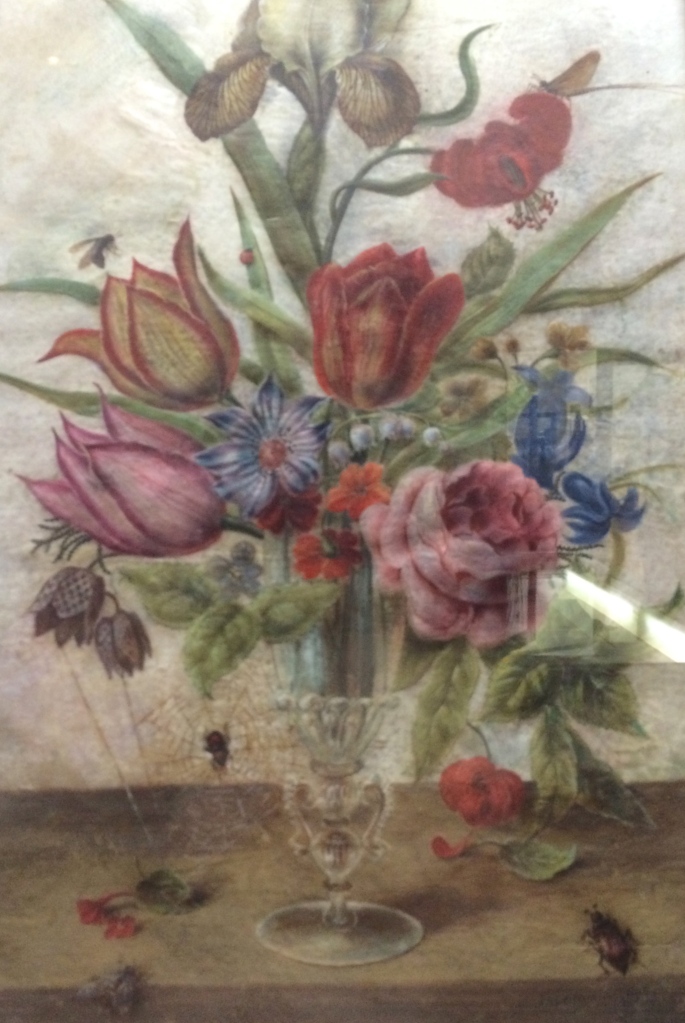
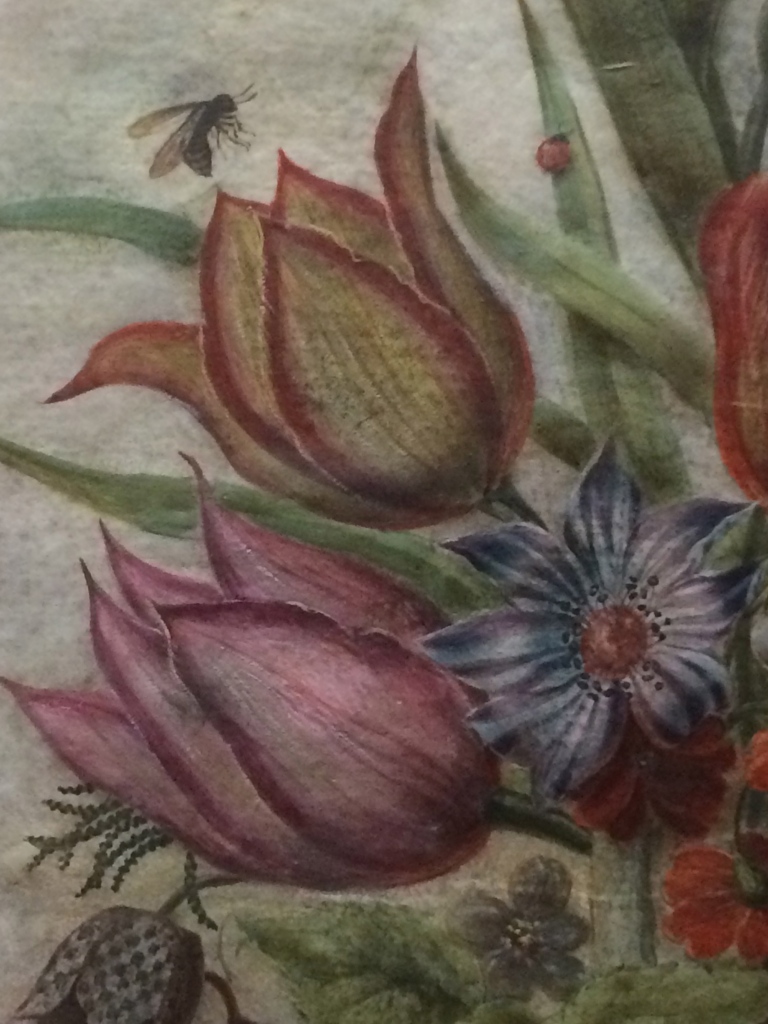
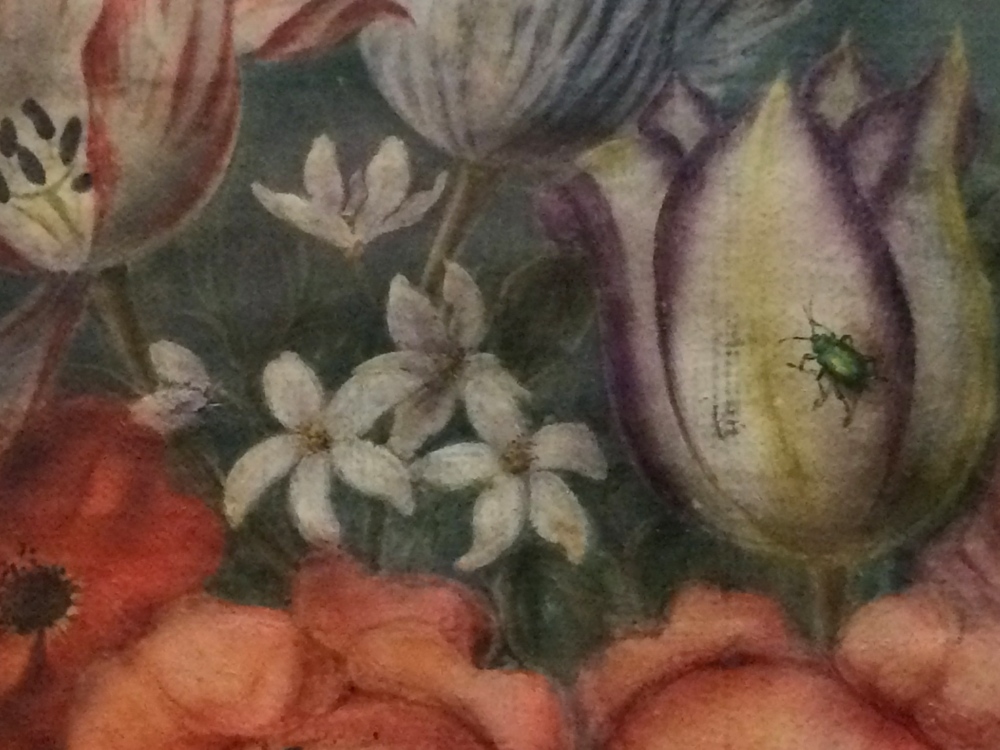 Venetian Glass Goblet with Flowers and Insects, Jacob Marel, 1634, plus a detail from ‘An Open Wicker Basket of Flowers with a Frog and Insects, Jacob Marel, Henry Rogers Broughton Bequest, Fitzwilliam Museum
Venetian Glass Goblet with Flowers and Insects, Jacob Marel, 1634, plus a detail from ‘An Open Wicker Basket of Flowers with a Frog and Insects, Jacob Marel, Henry Rogers Broughton Bequest, Fitzwilliam Museum
There is a more clinical, very handsome, series of drawings of carniverous plants by George Ehret including this unnervingly stolid drawing of a Stapelia – the carrion flower – a South African plant that generates the odour of rotten flesh to attract specialist pollinators.
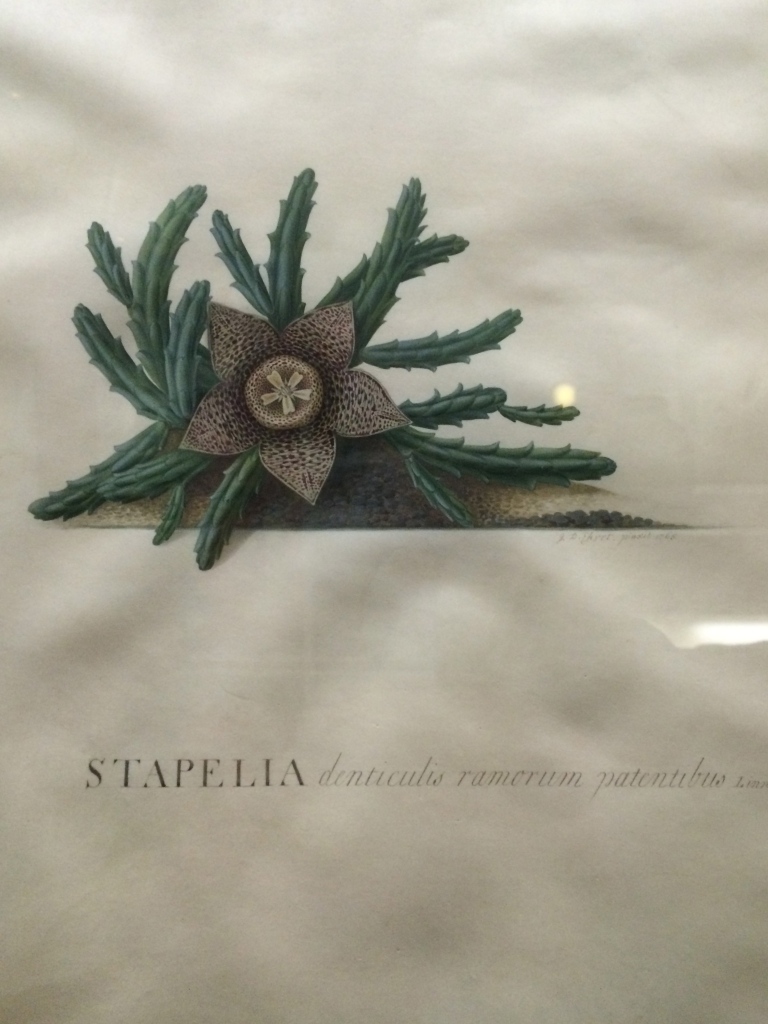 Stapelia, George Dionysius Ehret, 1765, Henry Rogers Broughton Bequest, Fitzwilliam Museum
Stapelia, George Dionysius Ehret, 1765, Henry Rogers Broughton Bequest, Fitzwilliam Museum
But from the moment I enter the exhibition my eyes are drawn to the pair of drawings by the Dietzsch sisters whose shared style of adding layers of opaque and semi opaque water-based pigments over a blackish ground results in powerfully quiet, almost ghostly paintings that tell knowingly of the fleetingness of life:
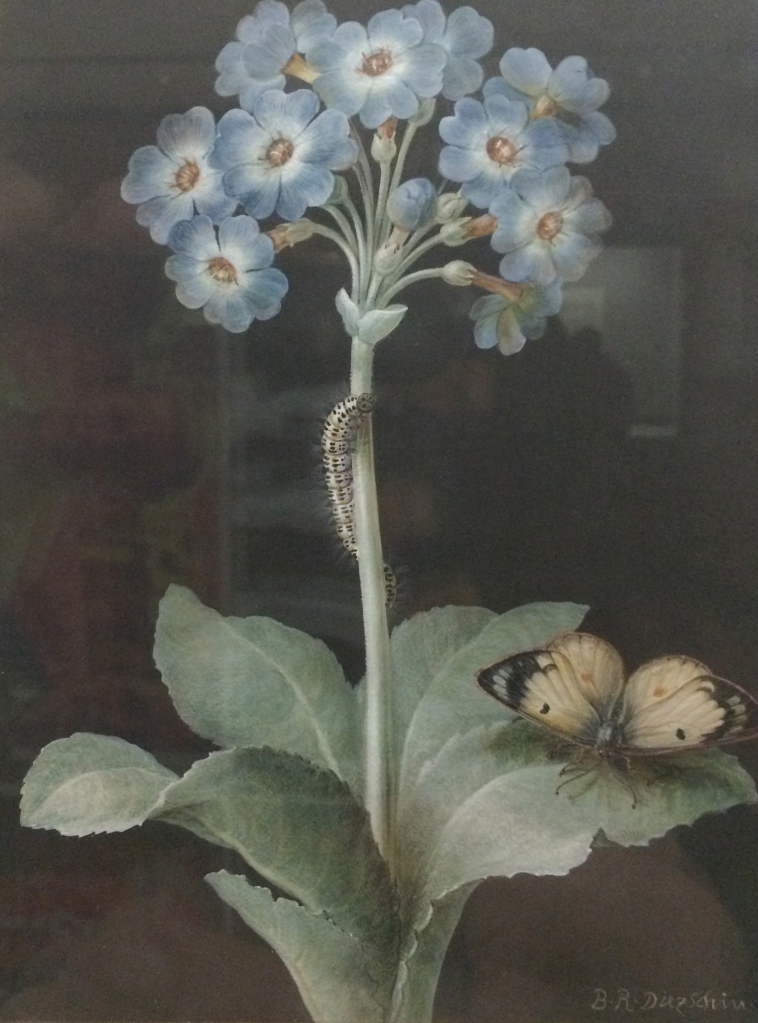 Primula auricula with a Clouded Yellow Butterfly, Barbara Regina Dietzsch (1706-1783), Henry Rogers Broughton Bequest, Fitzwilliam Museum
Primula auricula with a Clouded Yellow Butterfly, Barbara Regina Dietzsch (1706-1783), Henry Rogers Broughton Bequest, Fitzwilliam Museum
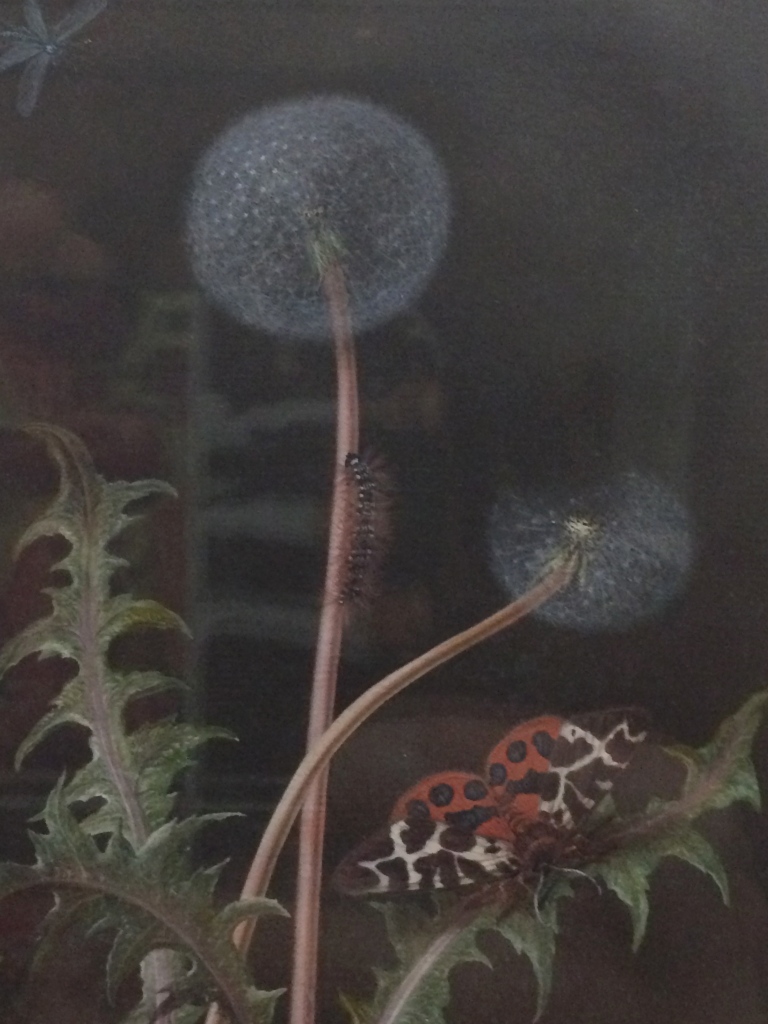 Common dandelion with a garden tiger moth, Margaretha Barbara Dietzsch (1726-1795), Henry Rogers Broughton Bequest, Fitzwilliam Museum
Common dandelion with a garden tiger moth, Margaretha Barbara Dietzsch (1726-1795), Henry Rogers Broughton Bequest, Fitzwilliam Museum
It is nearly time to retrieve Arthur. A quick misty-eyed glimpse at the bike-cluttered History of Art faculty which was pretty much my home for a couple of years.
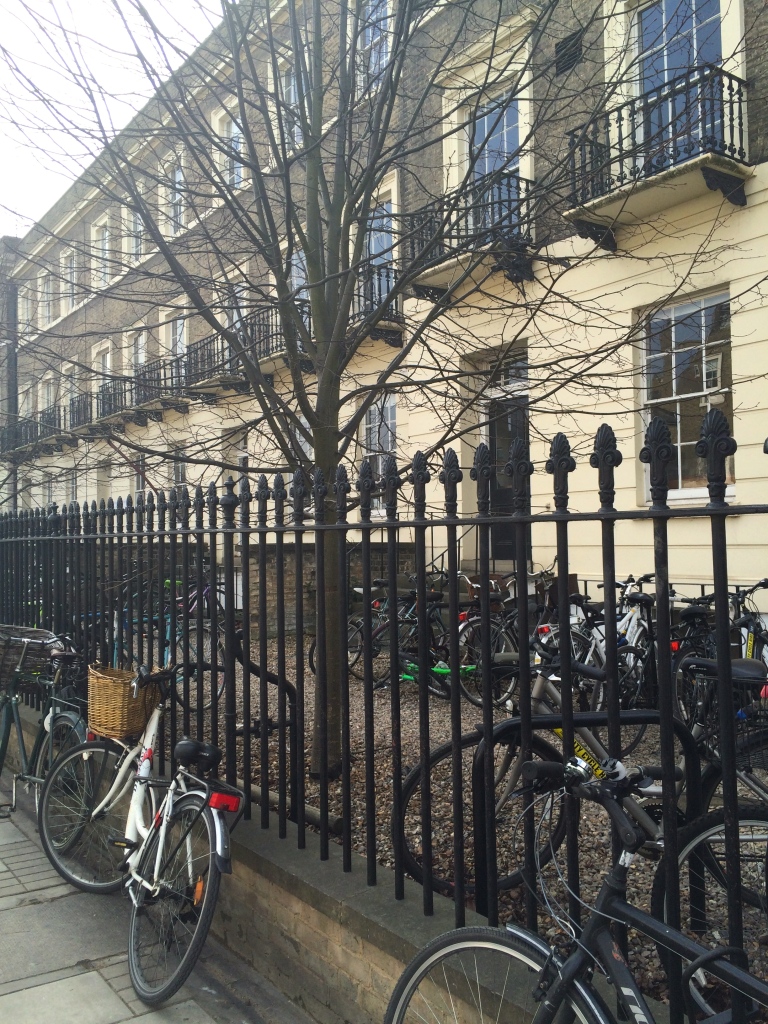 History of Art Faculty, Cambridge
History of Art Faculty, Cambridge
I am struck by the delightful difference in mood struck by the History of Art department’s fading nameplate against peeling stucco and the action-man (albeit of a certain era) stainless-steel-against-brick lettering of the Engineering faculty next door.
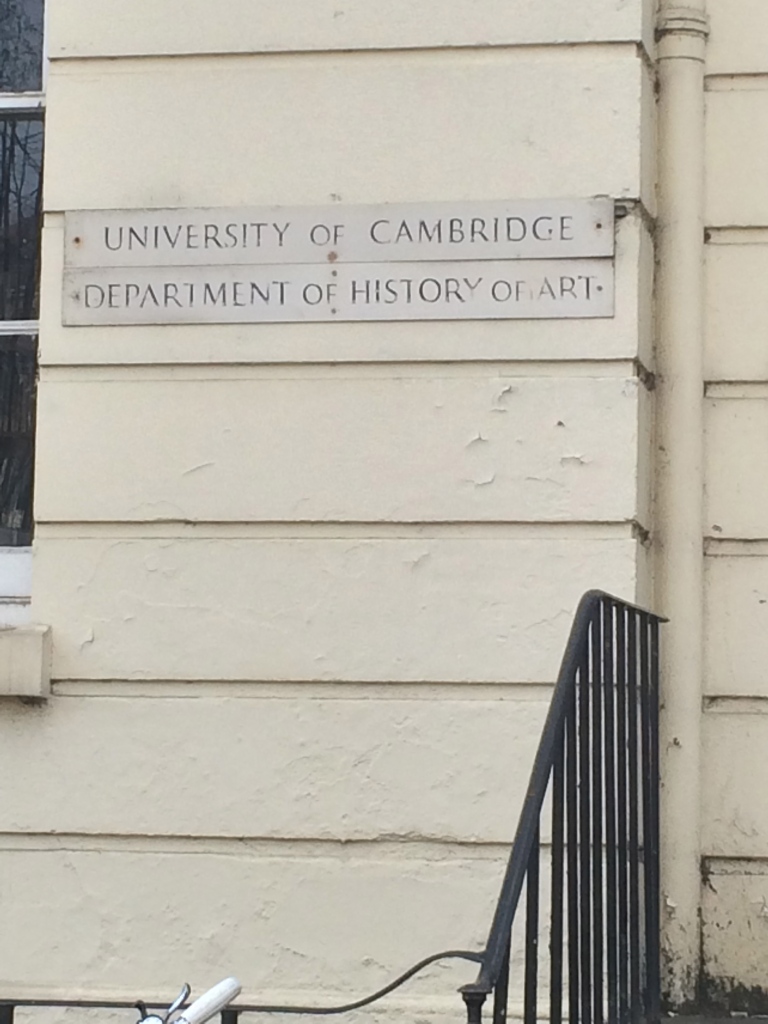
History of Art Faculty nameplate
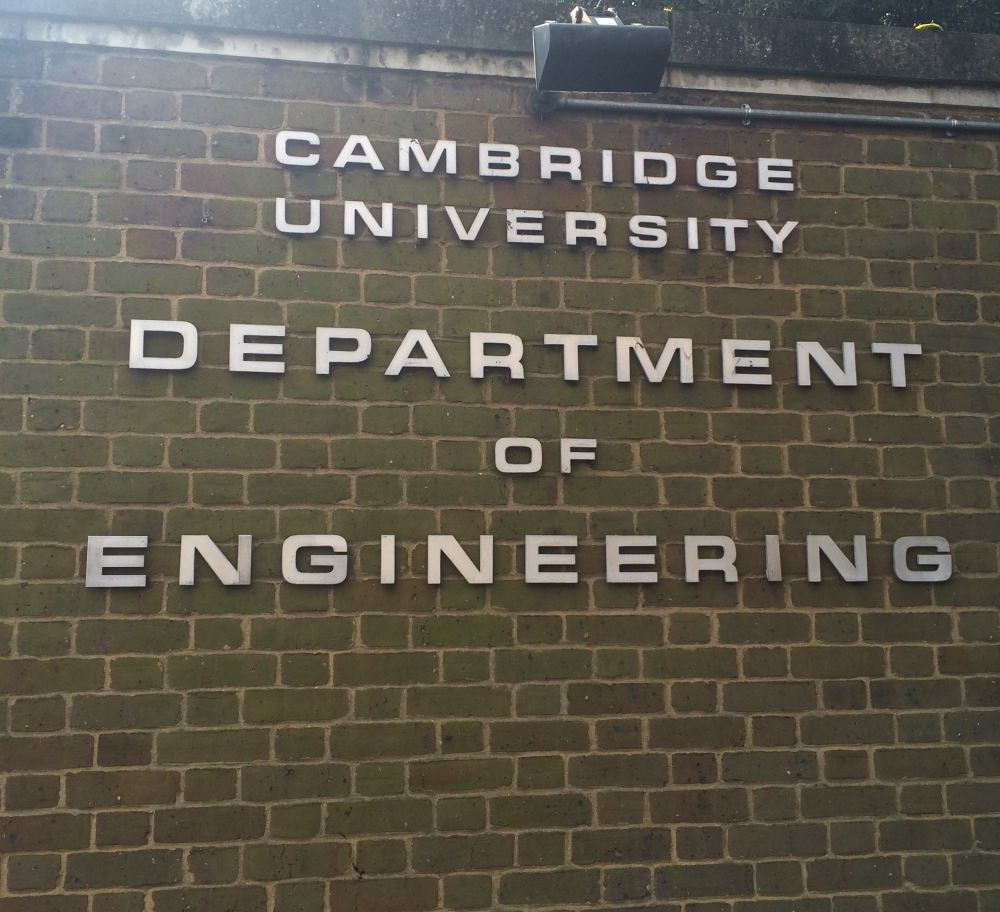 Department of Engineering nameplate
Department of Engineering nameplate
I am less misty-eyed that the favourite café for art historians and architects has changed its name from Martins – to Hot Numbers.

No time to sneak off to the Botanical Gardens with its glasshouses, dry garden, scented garden and systematic beds which will be soft with mulch and ready for the spring – but just time to tell you about my husband’s traumatic experience aged about 7 and at school in Cambridge. An exciting outing was proposed to the MECHANICAL GARDENS – how disappointed was he to find himself with a day of looking at trees and shrubs in the Cambridge BOTANICAL GARDENS.
 Cambridge Botanic Garden Systematic Beds (grouped in plant families) – I only went in for a moment!
Cambridge Botanic Garden Systematic Beds (grouped in plant families) – I only went in for a moment!
I meet up with Arthur by a railing smothered timelessly in University posters. He has emerged appropriately and unashamedly excited by the idea of tackling ‘ridiculously difficult’ German poetry and agrees cheerfully to visit one more garden on the walk back to the station.
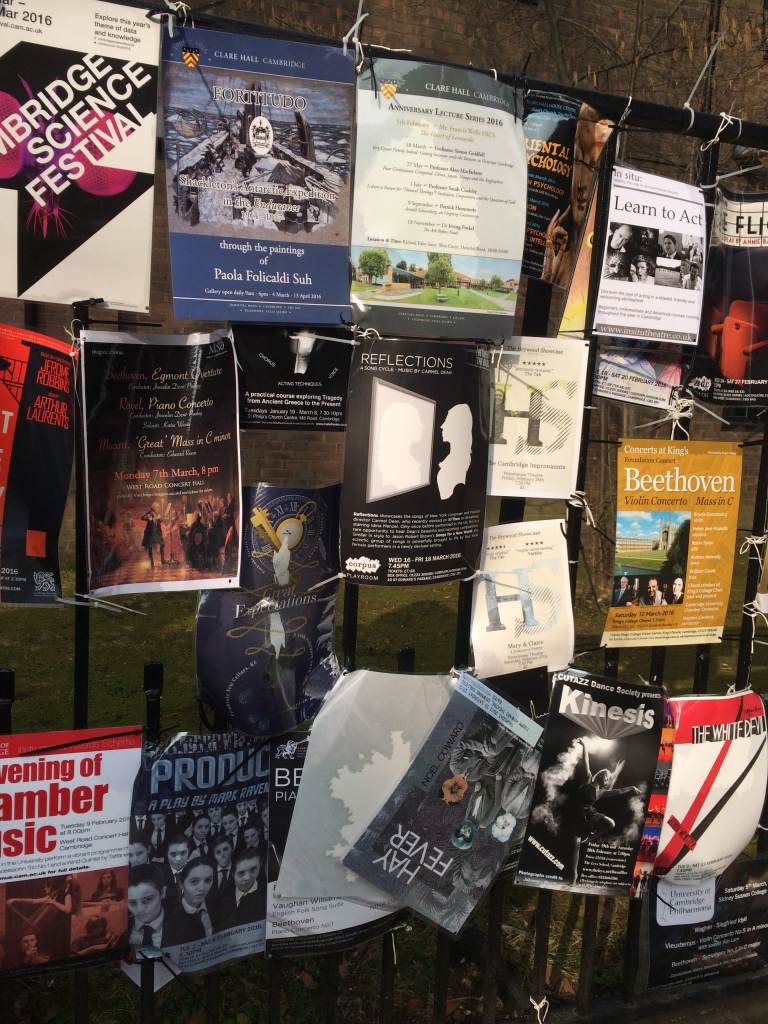 Poster smothered railing, Cambridge.
Poster smothered railing, Cambridge.
On Trumpington Street, next to Peterhouse College, we scoot in to the almost always open gardens of Little St Mary’s Church. You know you are onto a good thing when a Church sets a playful tone on page one of its website “Why ‘Little?’ Because down the road is the well known University Church, Great St Mary’s. We are smaller, but higher”.
This tiny semi-wild churchyard is a magical place, a listed City WIldlife site and brilliant because it is specifically gardened to nurture the feeling of wildness and seclusion.
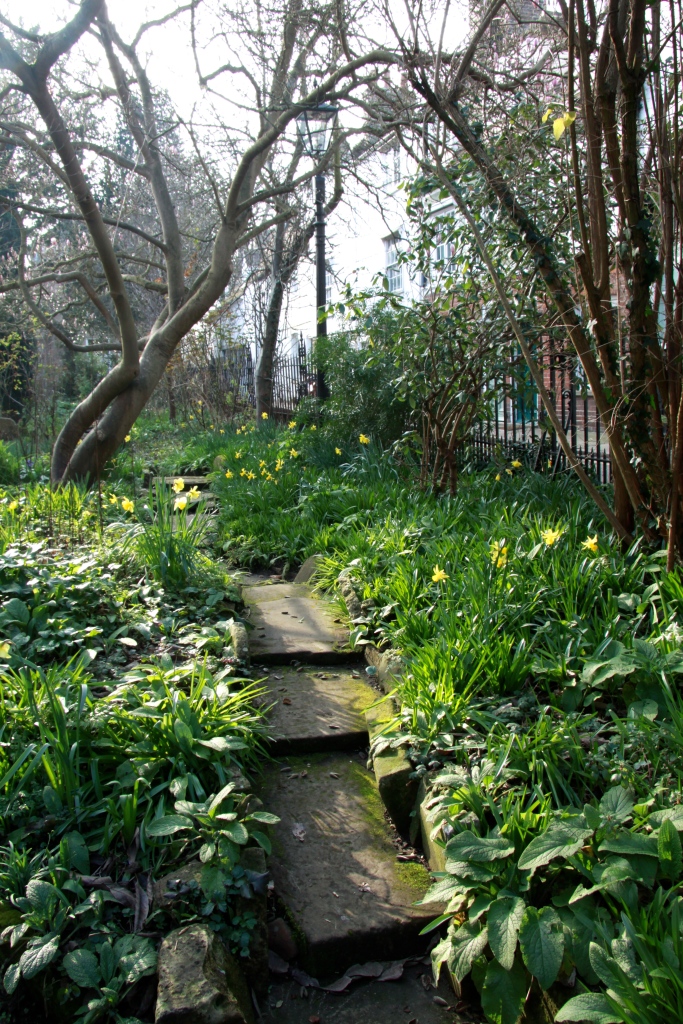 Path leading into Little St Mary’s Churchyard
Path leading into Little St Mary’s Churchyard
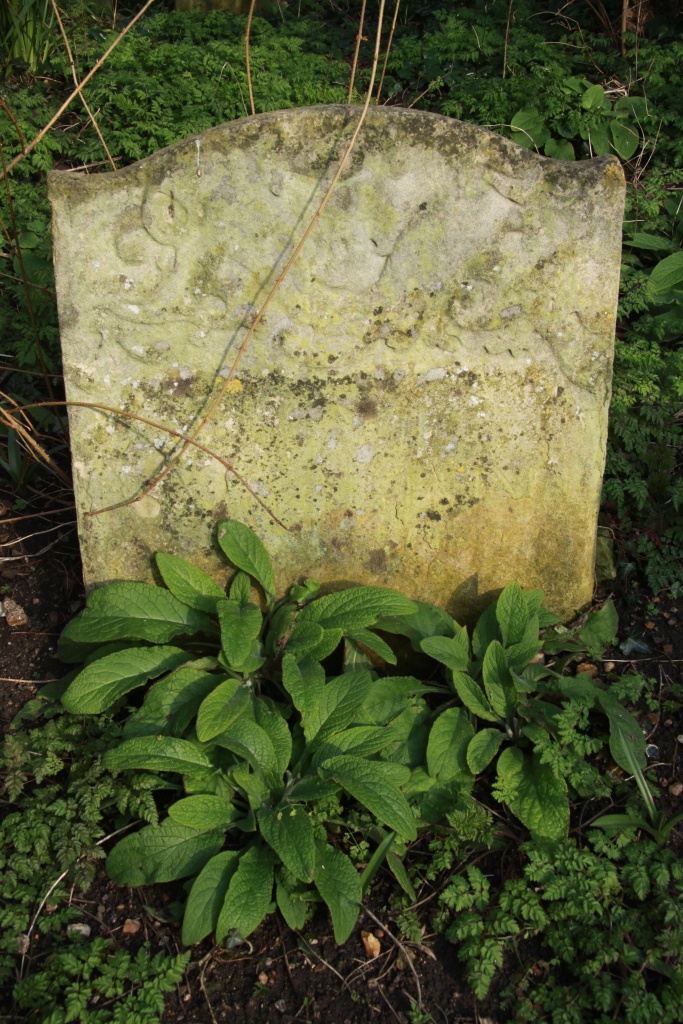 Gravestone with foxgloves
Gravestone with foxgloves
 Moss covered tomb seen through a screen of winter branches
Moss covered tomb seen through a screen of winter branches
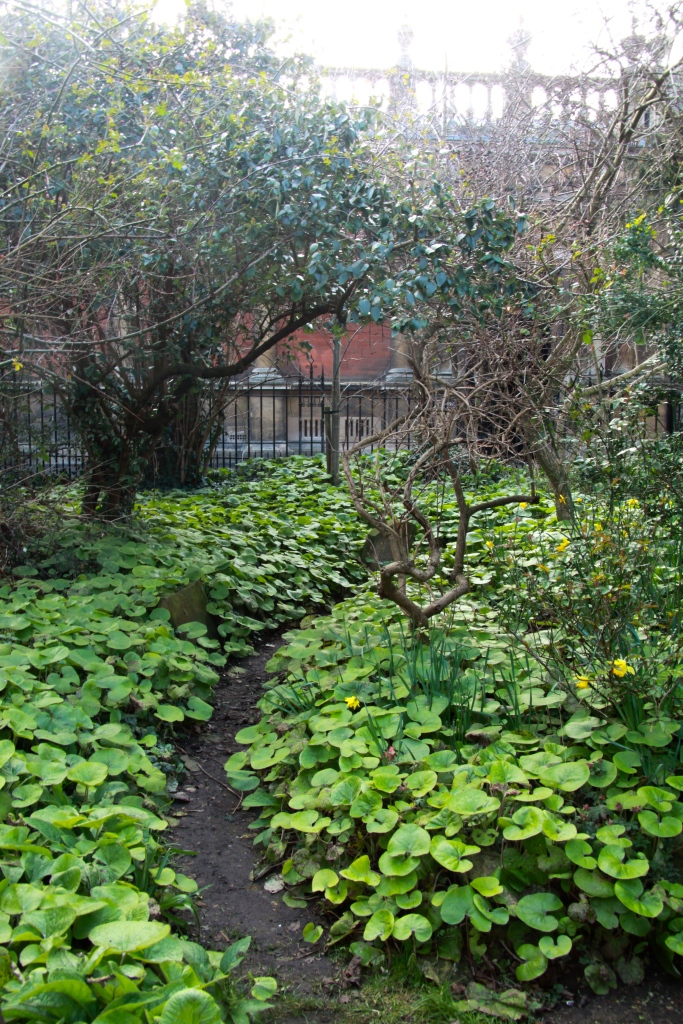
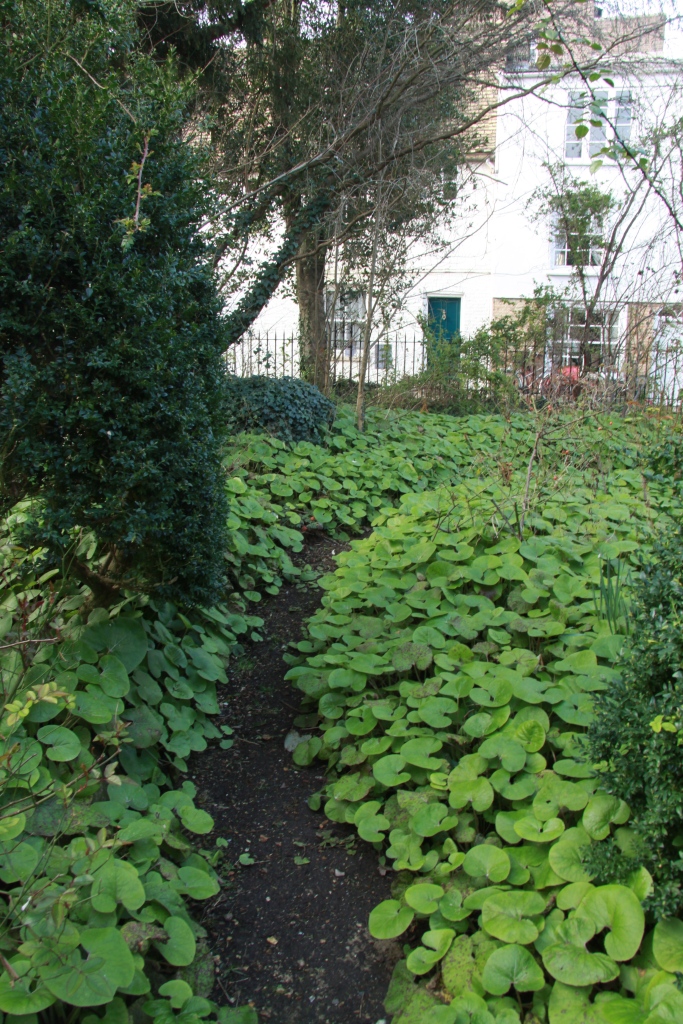 Narrow curving paths through lush heart-shaped leaves of Petasites fragrans
Narrow curving paths through lush heart-shaped leaves of Petasites fragrans
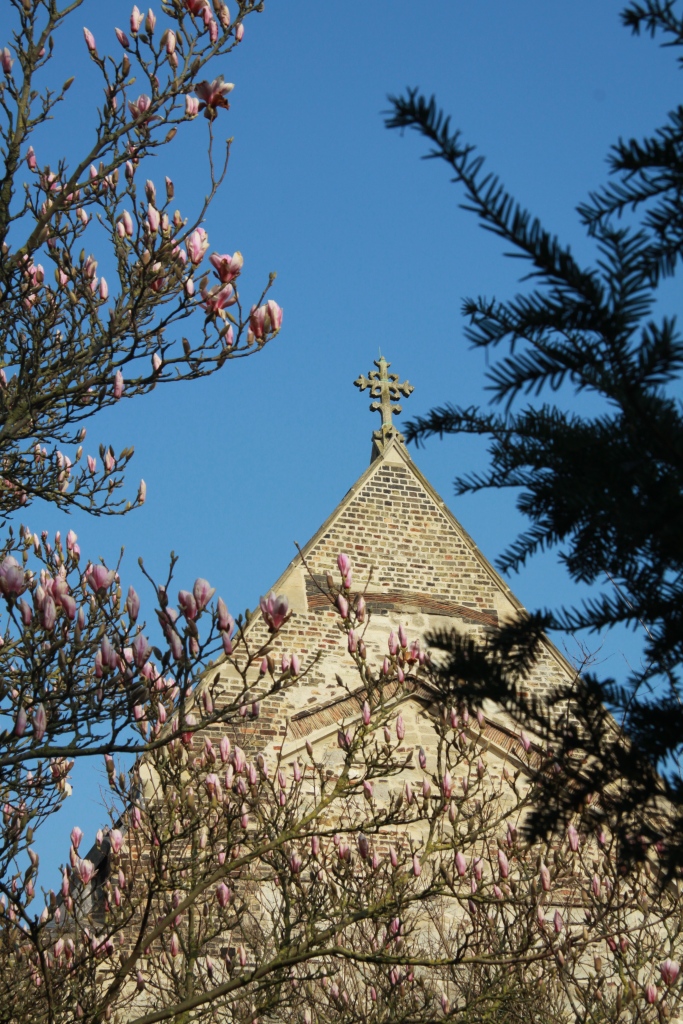 Soaring yew and magnolia against the Church
Soaring yew and magnolia against the Church
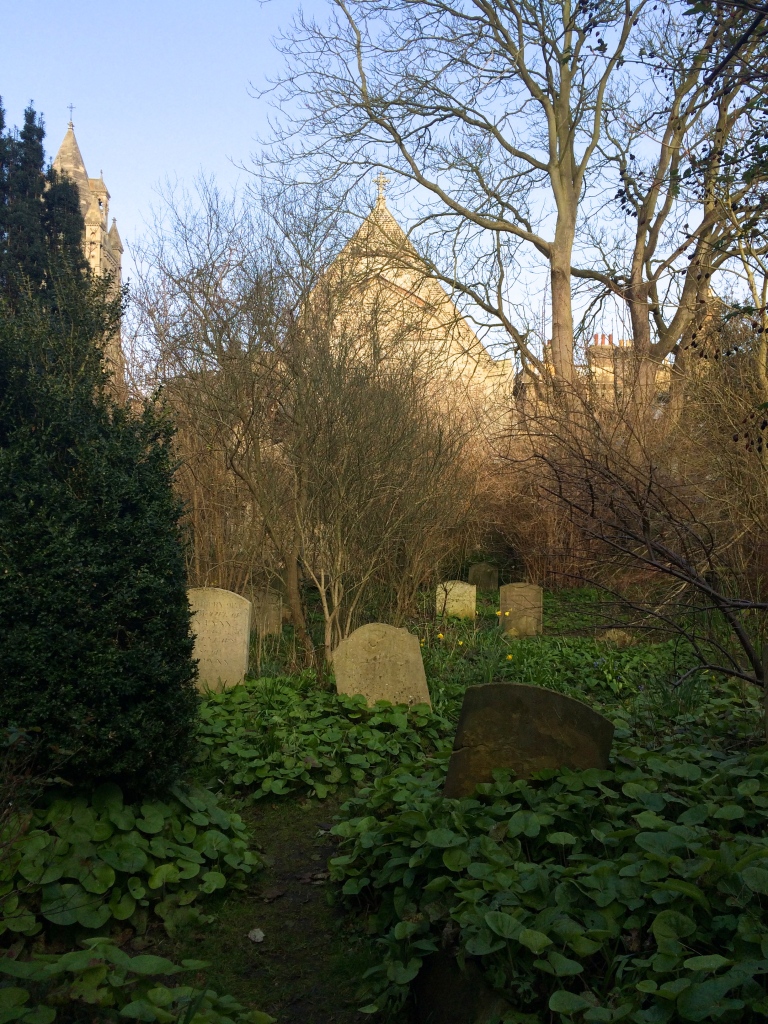 Roses, Philadelphus and yew share the space with ancient headstones
Roses, Philadelphus and yew share the space with ancient headstones
The transformation into this romantic and informal garden was masterminded by Robert Lachlan – a former churchwarden, Fellow of Trinity and distinguished mathematician. In 1925 the churchyard had become derelict. Lachlan used fragmented or fallen headstones to create a series of gently winding interlocking paths which entice the visitor to explore. Species roses and other flowering shrubs were planted to live alongside wild strawberry and sweet violet and the tradition of a secret garden, where the more invasive plants are kept in sufficient check to allow other plants to flourish, was begun.
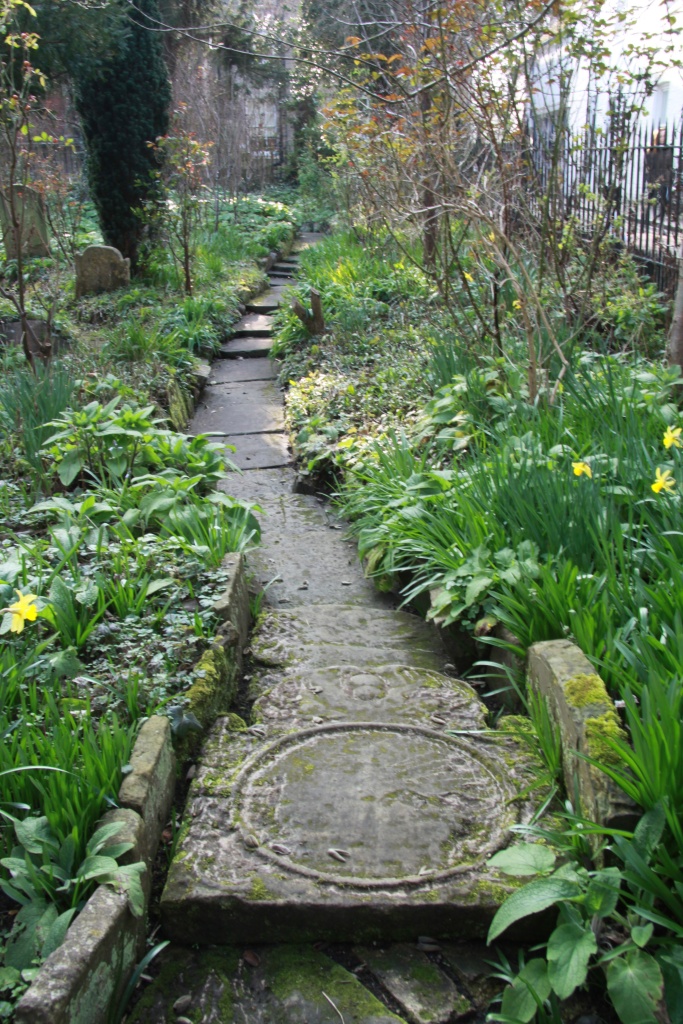
 Headstones used as steps and path
Headstones used as steps and path
The air throughout the garden is heady with scent from a champion Sarcococca confusa and there is a feeling of thoughtful layers to the planting, careful placing of benches, cherishing of new plants. A quiet example of this is the fleet of gravestones running down the side of the church, each with a small cloak of snowdrops floating steadily in its wake.
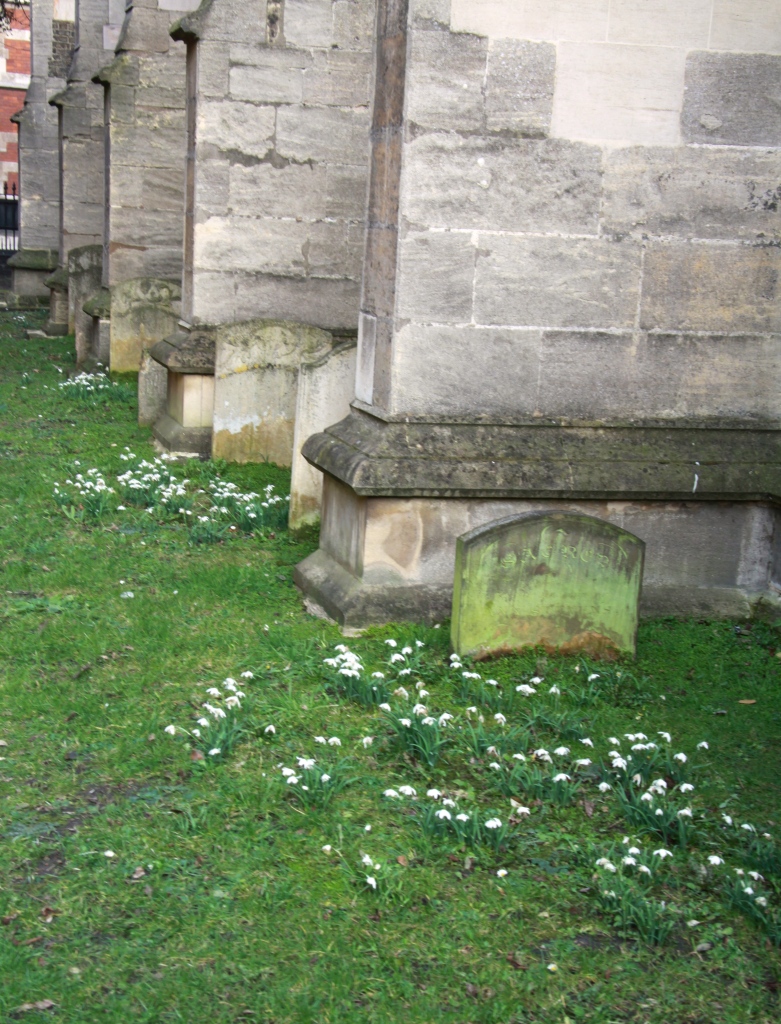 A fleet of gravestones each with a small cloak of snowdrops floating steadily in its wake.
A fleet of gravestones each with a small cloak of snowdrops floating steadily in its wake.
Applying to Cambridge these days is as hard a mountain to climb as any Northern peak tackled by Dr Macfarlane. But for everyone who succeeds, this would be an excellent secret place to disappear to once in a while.
 Dancing seedheads against late afternoon light, Little St Mary’s Churchyard, Cambridge.
Dancing seedheads against late afternoon light, Little St Mary’s Churchyard, Cambridge.

Non’s beautifully written piece on Cambridge xxxx
http://www.doeleather.co.uk 07584 161282
>
You are the kindest reader always, much appreciated, Nonx
Dear Non, Magnificent! I love the paintings and your descriptions. It is also becoming Spring-like in New York City and the Honeybees both here and in Murano are already busy. I wish you and your family a beautiful Primavera. I look forward to your blogs and gorgeous photos.
I am working on new art for the 2017 Venice Biennale related to my Honey Garden and the Murano Honeybees. I hope you will visit!
Dancing seedlings forever…
Judi
Dear Judy – so glad you enjoyed my Cambridge post. Fantastic that you are preparing for the next Biennale – a very tempting idea to visit you later this year.
Enjoy New York as you get the first taste of Spring, Non x
Thanks Deborah x
Another wonderfully expansive and thoughtful piece Non … As my tiny contribution I can’t help pointing out that the briefly pretty trees in the rather icky Emmanuel gardens are plums, not cherries (Prunus cerasifera ‘Pissardii’) ….
Hi Michael Very glad you enjoyed my post. Thanks for pointing out my stupid mistake re: Prunus cerasifera – I tell you, if you relax for just a moment! Very best wishes, Non
Evocative and educational, thank you Non for another treat of a post. x
What a lovely review of Cambridge. A great reminder to do another visit soon; it’s exciting as we can now do this easily, having just moved back to the UK this month . My husband spent eight years at the university (before we met) so I reckon it won’t be too hard to get a weekend in the city agreed with him. I do remember being there at crocus time one year: so beautiful but oh so cold!
Hi Janna Thanks so much for your enthusiastic response to my blogpost on Cambridge gardens – I understand why the City is close to your heart! Definitely worth a visit when you have the chance and to look at it through gardeners’ eyes. Thanks too for following THE DAHLIA PAPERS. All the best, Non